Complaints About Boston College Priest Sent to Leahy, Jesuit Provincial Years Prior to Rape Allegation
Julia KiersznowsKi Assoc. News Editor Victor stefanescu Asst. News Editor amy Palmer Asst. News Editor megan Kelly News Editor


Members of the Boston College community sent complaints beginning in the 1997-98 academic year to University President Rev. William P. Leahy, S.J., accusing Rev. Ted Dziak, S.J., a Jesuit at BC from 1990 to 1998, of inappropriate conduct with students.
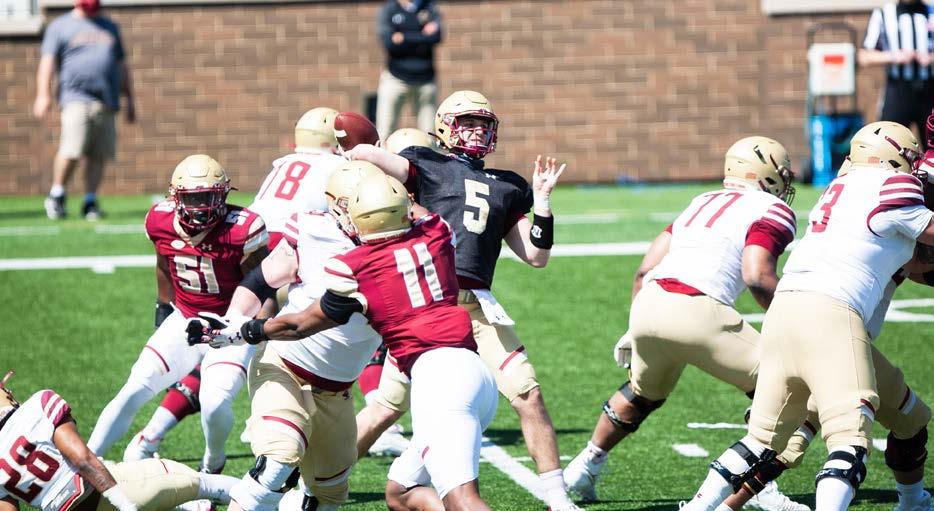
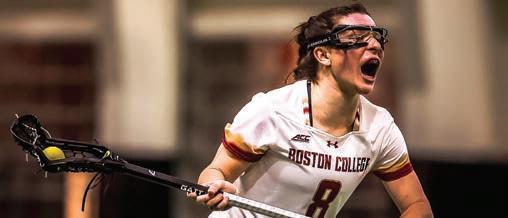
Dziak—who went on to work at Jesuit schools in Jamaica, New Orleans, and New York—was accused last week of raping a postgraduate volunteer in Belize in 2004, according to nola.com. In one instance, members of the chaplaincy—which is now Campus Ministry—submitted a letter to Leahy during the 1997-98 academic year containing student complaints about Dziak’s troublesome behavior.
In the spring of 1998, Dziak announced he would be leaving the University for a position at a school in Jamaica.
Matt Stautberg, BC ’99, said he met with Leahy in the summer of 1998, while Dziak was on his way out of BC, to discuss the Ignacio Volunteers program, which Dziak had been directing since 1991. During this meeting, Stautberg said he also brought up Dziak’s troubling behavior.
“At that point I was more focused on continuing the program and finding us a new staff person to help,” Stautberg said. “But I did express that [Dziak] was inappropriate. Childlike stuff, where he wouldn’t talk to chaplaincy … My memory was that [Leahy] was very thoughtful and listened
and [was] understanding.”
Stautberg also wrote a separate letter— of which he sent Leahy a copy—in the fall of that year to Rev. Robert Levens, S.J., the provincial, or leader, of the New England Province of the Society of Jesus at the time. In the letter, which was obtained by The Heights, Stautberg describes how Dziak emotionally abused him and expressed that he did not think Dziak should continue working with young people. Beth Eilers, BC ’97 and BCSOE ’99, also wrote a letter that was obtained by The Heights to Levens on March 18, 1999, where she emphasized Dziak’s pattern of emotional abuse. Leahy was copied on Eilers’ letter as well.
Tim Ballard, a DePaul University graduate and a volunteer who served from 2004 to 2006 through Jesuit Volunteers International (JVI)—an organization launched by Dziak—alleged that Dziak raped him four times during a trip to Belize. Three of those times, the two had been drinking together, Ballard said, and Ballard alleges that he was drugged all four times. BC has not made any public statement regarding allegations against Dziak or whether Leahy read the letters sent to him, but directed The Heights to the USA East Province of the Society of Jesus, which was established in 2014 to combine the New England and New York provinces and could not immediately be reached for comment.
Though Dziak took over Ignacio Volunteers at BC in the 1990s, this was not his first time directing a volun-
New Gun Store Ignites Controversy in Newton
applicant met the qualifications for a license, Fuller said.
teer service program. Dziak launched JVI through Georgetown University in 1984, which placed college graduates into international service experiences, according to Jesuit Volunteer Corps. Dennis Heaphy, an early volunteer at JVI, told nola.com that Dziak tried to get the two to watch movies and drink beer together, and the priest was angry when the invitations were denied.
Dziak also kissed Heaphy on the head and said “I love you” while the two were traveling to Belize, Heaphy said.
Heaphy’s time in Belize was cut short by a diving accident that left him paralyzed, according to nola.com. Decades removed
said. “‘The group that I took here last time got naked around each other much more frequently. They were a lot more open with their nudity, you know, and I don’t feel that this group has achieved that level of comfort yet.’”
Jose Tamayo, BC ’97, said he volunteered with Ignacio Volunteers in Jamaica his senior year and in Belize the following winter as a group leader.
Tamayo said that during the first trip he had a friendly and light relationship with Dziak, but noticed that the graduate group leaders constantly seemed exhausted.
“It was like visible stress, visible exhaustion,” he said. “Physically run down. Like worn out, wrung out.”
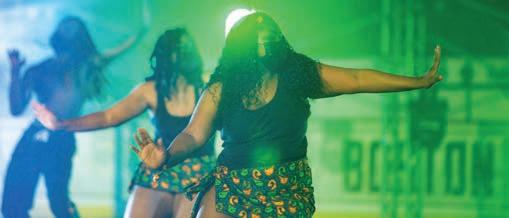
Tamayo said he didn’t understand the leaders’ frustration until he became a graduate leader in Belize the following year and experienced emotional abuse at the hands of Dziak.
who was granted anonymity out of fear of retaliation from BC, said they heard things about Dziak’s misconduct even before they came to BC in the early 1990s.
“I had friends who had worked in the Jesuit Volunteers International—there was, like, a whole group in Boston of all these former Jesuit volunteers,” the chaplain said. “So, through that network, I had heard a few things about Fr. Dziak, concerns, before I got to BC.”
Through their work on service programs at BC, the chaplain said they became close to students who said that Dziak had traumatized them. The chaplain also said student leaders would often share stories about how the priest made students uncomfortable.
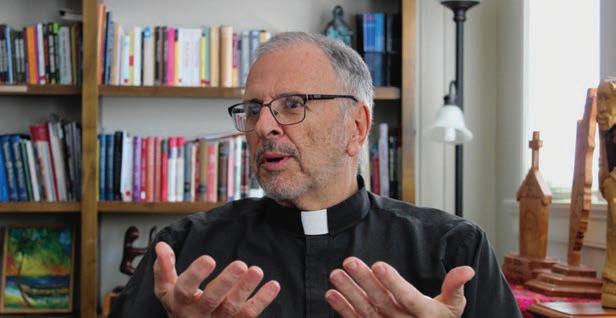
Stautberg joined Ignacio Volunteers as a freshman in 1995. Throughout his time with the program, Stautberg said that Dziak repeatedly made it clear he wanted to be close friends with him. When Stautberg didn’t reciprocate these feelings, he said, Dziak grew frustrated.
from the trip, Heaphy said he still remembers Dziak’s actions.
“Ted used the classic steps of a pathological abuser,” Heaphy said to nola.com.
Jeffrey Robinson, BC ’00, attended a trip to Belize with Dziak through BC’s Ignacio Volunteers program. Robinson said that Dziak encouraged the attendees to change their clothes in front of one another during the trip.
“He came into the room and was visibly upset or emotionally upset, and what he said to us was ‘This group doesn’t seem to be open with one another,’” Robinson
“Immediately, he turned very hostile,” Tamayo said. “He never told you what you needed to do, or what there was to do. And anything you did was wrong. It was like a trap every time.”
Dziak would keep group leaders awake until the late hours of the night, and also wake them up hours before the other volunteers, Tamayo said.
“I mean, I think I got three hours of sleep a night for the length of the trip,” he said. “And of course that messes with you and it gets very edgy. It’s like a torture.”
A former BC chaplain who worked alongside Dziak on service programs,
“He said things and wrote things and left voicemails … telling me that I was wrong because I wouldn’t be his friend and what was wrong with me and questioning if I was really serious, really making me doubt myself,” Stautberg told The Heights told Stautberg that he was leaving BC before the news of his departure became public.
Stautberg said Dziak would open up to him about problems he was having with Levens, the provincial at the time, as well as with BC.
He also said Dziak told Stautberg that he was leaving BC before the news of his departure became public.
J ulia r emicK Metro Editor
The possibility of a gun store, Newton Firearms, opening in Newton has been met with opposition by Mayor Ruthanne Fuller, all 24 members of the Newton City Council, and members of the community.
“The news of a firearms dealer wanting to open in Newton comes after years of so many mass shootings in so many places from schools, theaters, and concerts to grocery stores and business places,” Fuller said in a statement on Thursday. “It comes after so many gun deaths reported on the news seemingly every day, ranging from a stray bullet killing a grandmother on a front porch to a teenager on the street to a convenience store clerk during a robbery.”
Newton Firearms advertises a firearms sale floor, ammunition, gun accessories, safety training, and other services, according to its website.
Fuller first learned that a proprietor applied to open a gun store a few weeks ago, she said. Although Fuller and the council asked Interim Chief of Police Howard Mintz and the Commissioner of Inspectional Service if it was possible to deny a license, they were told that the
Newton does not currently have zoning in place to regulate where a gun store can open and relies on state and federal regulations of gun sales, according to Fuller. Fuller and the council signed an amendment to the city’s zoning ordinance on April 16. If passed, this ordinance would restrict all firearms dealers in particular zoning districts. The council made the proposed zoning amendment publicly available on Friday.
“The revised zoning ordinance would also require businesses of firearms sales uses to be approved only by special permit by the City Council and will create specific special permit criteria, including a buffer zone between a firearms dealer and potentially residences, schools, parks and other sensitive locations,” Fuller said.
Newton City Council will discuss the proposed Firearm Business Use Zoning Amendment for the first time during the Zoning and Planning Committee meeting on Monday. Public comments will not be allowed at this meeting, but the council will hold a public hearing about the ordinance on May 10, Fuller said.
Following the public hearing and input from the community, the council will recommend the ordinance to the full council for a final vote.
Monday, April 26, 2021
INSIDE NEWS: Green Week EcoPledge celebrated Green Week with events Monday to Friday of last week...... METRO: Local Art Displayed Art adorns the fronts of vacant stores throughout the Newton area........................... INDEX Vol. CII, No. 10 © 2021, The Heights, Inc. www.bcheights.com SHOWDOWN ARTS Despite the event being moved online, BC dancers still put on a performance. A5
of the year. A12 NEWS......................... ARTS........................ MAGAZINE................. OPINIONS............. METRO.................... SPORTS................... Many in the community oppose a firearms business. Right Where They Left Off In the annual Jay McGillis Memorial Spring Game, Phil Jurkovec and Zay Flowers led Team Boston over Dennis Grosel and Team Eagles. See Gun Store, A10 A8 A10 A11 A2 A4 A6 THIS ISSUE A2 A10 See Dziak, A3
LACROSSE SPORTS Charlotte North, a Tewaaraton Award nominee,
was held scoreless in BC’s second loss
See April Showers, A12 IKRAM ALI / HEIGHTS EDITOR
PHOTO COURTESY OF THE LOYOLA MAROON AND JAWDAR TINAWI
EcoPledge Focuses on Climate Crisis for Green Week
BY MEGAN GENTILE Copy Editor

This year, programming during EcoPledge’s celebration of Green Week centered around the topic of climate change, according to Autumn Hauser, president of EcoPledge.
“The theme for Green Week this year was intersectionality of the climate crisis, which emphasized the interconnectedness of environment, health, and justice,” Hauser, MCAS ’21, wrote in an email to The Heights “Independent of an individual’s major or interests, there is an aspect of their life or future career that will be, or already is, touched by climate change.”
EcoPledge, a student-run sustainability coalition at Boston College, celebrated Green Week Monday through Friday last week with
various events that encouraged sustainability and green practices.
The week included both in-person and virtual programs, such as an alumni panel on green careers, a presentation on the United Nations’ sustainable development goals, and a movie screening of 2040, which discusses the impending effects of climate change over the next 20 years.
Hauser said that while planning for Green Week, she met with various sustainability leaders at BC, including Tara Pisani Gareau, director of the environmental studies program and faculty adviser of EcoPledge.
“At that time, we expected all of the events would be virtual,” Hauser wrote.
“Once we returned for the spring semester, we organized biweekly Green Week planning meetings over Zoom in which eco-leaders at BC, including individuals from Real Food, BC
Dining, CJBC, and the UGBC Environmental Division. … There are many moving pieces when organizing a combination of virtual and in person with numerous groups.”
EcoPledge also hosted various in-person events, including a tree-planting ceremony as part of the 4C Tree Project on Thursday afternoon and an Earth Day Fair on Friday.
Although the COVID-19 pandemic presented some challenges, such as abiding by state and University regulations, it also allowed the group to be more creative when planning events, according to Hauser.
“For example, we featured Dr. Kumar, who does research on the UN Sustainable Development Goals, and AY Young, a musician, climate activist, and UN recognized leader, together in a virtual webinar,” she wrote. “Under other circumstances, we may have been tempted to only feature one
individual in a keynote speech.”
At the Earth Day Fair, various organizations presented on the green initiatives their groups were working on.
Colleen Conley, a BC Dining representative and Lynch ’23, said that diet and sustainability go hand in hand.
“I feel like we’re kind of specifically here to spread awareness about how your diet and the way that you eat affects our environment and, like, how small changes to your diet can make a big difference,” Conley said.
Lauren Anton, a representative from Outdoor Adventures and MCAS ’22, said exposure to wilderness makes the effects of waste more apparent.
“When you’re out in the wilderness, it’s when you really get to see all of nature’s beauty and everything that the Earth provides for us that you sometimes forget about when
you’re going through your normal college routine,” she said.
Other aspects of the Outdoor Adventures presentation included discussion on how to promote diversity in the outdoors.
“Often, it’s a very white place to be,” Ethan Daly, Outdoor Adventures representative and MCAS ’22 said.
Hauser said she is proud of how the week was executed and of the teamwork involved in putting it on, and that she looks forward to seeing green initiatives at BC develop further after she graduates.
“I am ecstatic that we were hopefully able to facilitate conversation surrounding inclusivity and intersectionality of climate change,” she wrote. “My hope is that individuals that attended the events throughout the week were able to gain a new perspective on environmentalism.”
SAP Resumes In-Person Tours for Admitted Students
B Y J ULIA L ANDWEHR Heights Staff
Small groups of admitted students are being welcomed back on campus for in-person tours during the month of April—it’s the first time prospective students have been allowed to participate in on-campus programming since Boston College first closed in March 2020.
“I’m very excited that tours are coming back and we’re having visitors on campus again,” said Annie Xie, tours coordinator for the Student Admission Program (SAP) and MCAS ’21.
Xie has been involved in SAP for the past four years and has seen the admissions process go through some major overhaul in recent months, she said.
“In previous years, we would have, like, hundreds of visitors every single day, they would be everywhere, and [we’d] have large tour groups with 30 to 40 people,” Xie said. “That definitely looks different because now we are only having up to 20 visitors in a single time slot. So, that’s 20 visitors in the timeslot v ersus 250 visitors in the time slot.”
Limiting the number of prospective students on campus hasn’t been the only change the BC admissions process has undergone. Now, only students admitted in the regular decision pool—those still in the process of making their college decision ahead of the May 1 deadline—are allowed to
book on-campus tours, and they can only bring one guest with them.
In order to make following COVID-19 restrictions easier, the format of tours themselves has also been updated, according to Director of Undergraduate Admissions Grant Gosselin. Tour guides’ routes now avoid the busiest parts of campus and are outdoors only. Presentations during tours have also changed so that prospective students don’t have to crowd around their guide.
“What we’ve done is we’ve set up predetermined locations on campus. The tour guides bring the group to that spot. Everyone spreads out, and then they present from that spot about all the things from that part of campus that they feel they ought to know,” Gosselin said. “They field the questions from that point, and then they move on to the next stop on the tour. So, it’s really worked well to give people the chance to get their questions answered, and do so in a safe way.”
Throughout the process of bringing back in-person tours, safety has been a priority, according to Gosselin and Xie.
“We started working on this back in November and mapping out a plan for how we could do this safely to protect our own community, and also to keep the safety of our visitors in mind,” Gosselin said. “We thought a lot about the safety precautions that we could put in place.”
Guests welcomed on campus are
given clear directions to maintain physical distance from other families, wear their masks at all times, and complete a health check prior to the tour, Xie said. Gosselin said he thinks that having a sanctioned way to visit campus is safer for both prospective and current students.
“We also knew that many students would come to campus to walk around, whether we invited them or not,” Gosselin said. “And so, we felt that having something very set in stone, with very clear safety guidelines and expectations would actually help protect the community.”
For those who don’t want to travel to BC or for those that cannot snag a tour spot, BC admissions continues to offer comprehensive virtual programming. Xie said that most other programming, including Eagle for a Discussion, panels, information sessions, and the Keith A. Francis AHANA+ Weekend have all gone virtual, but that SAP works to make it as interactive as possible.
There are also around 30 virtual events for admitted students during the month of April, and a pre-recorded audio tour of campus with detailed photos, Gosselin added.
“I think we’ve done an exceptional job of providing variety for students and helping meet them where they are in terms of what they feel comfortable with, and for some students that might not be able to travel here, giving them as many resources as we possibly could,”
Gosselin said. In his conversations with families and prospective students, though, Gosselin said that most say coming to campus is a much-preferred option.
“They’re thrilled to be here,” Gosselin said. “I would say half of the people that I’ve talked to have never been on a college tour before this one. This is their first college tour ever. And so, just the excitement of being able to be here has been very, very apparent.”
Gosselin said that many have asked about what the fall semester may look like. On Friday, BC announced that it would require vaccinations for all students coming to campus for the next academic year. Other students, Gosselin said, don’t know how to compare schools when they’ve seen some in person and others only online.
“It’s not the same reading about something as it is seeing it in person,” Xie said. “I think that’s one of the main challenges of the students so far.”
Though virtual programming might not be the same as seeing BC’s campus in person, Gosselin and Xie both said that expanding the admissions office’s online programming has had its benefits.
“Our biggest goal is to move everything back in person that we can as soon as possible, because nothing can really match that,” Xie said. “But, something that we realized is that virtual programming offers an opportunity to reach a lot more students, especially students who don’t have the capabilities to visit campus, whether that’s a financial constraint or a geographic constraint.”
BC Expands Cultural Diversity Core Requirement
B Y E MMA H EALY Sports Editor
Nearly 30 years after its addition to Boston College’s core curriculum in the fall of 1991, the cultural diversity core requirement has expanded to further address the changing cultural makeup of both the University and the world, according to Elizabeth Shlala, assistant dean for the core curriculum.
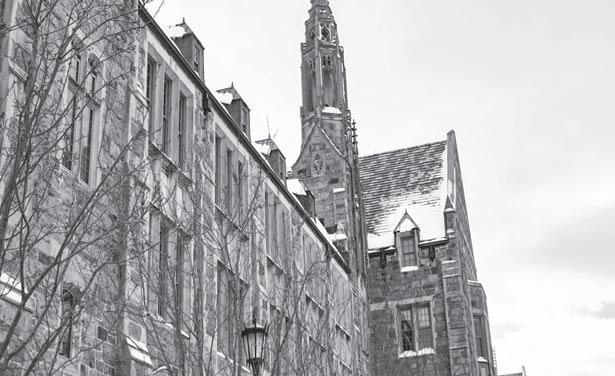
BC added two new pathways through which BC students can meet the cultural diversity requirement: Engaging Difference and Justice (EDJ) and Difference, Justice, and the
Common Good in the United States (DJCG).
The tracks include courses in three of BC’s four undergraduate schools. Courses range from Reimagining School and Society in the Lynch School of Education and Human Development, to Gender, Sexuality, and Power in the Ottoman and British Empires in the Morrissey College of Arts and Sciences, to Managing Diversity in the Carroll School of Management.
“As part of the Core Renewal process, there has been a call to expand the course offerings to further meet the challenges of our times,” Shlala, who is also an associate professor of
the practice for the core curriculum, said in an email to The Heights
The Engaging Difference and Justice track includes five major learning goals, all of which aim to help students understand how free societies can create and foster “mutual respect” for their members, according to Shlala.
These courses focus on the importance of community in various contexts, ranging from familial relationships to global interaction through shared values, inclusion, and solidarity. They seek to explore complex issues concerning race, class, gender, sexuality, ability, religion, and other sociocultural categories, Shlala
said in the email.
Difference, Justice, and the Common Good in the United States seeks to fulfill three major learning goals to meet the cultural diversity requirement, according to Shlala.
“Students will be able to explain how power shapes differences and creates injustices in the United States, and how power can be used to achieve justice,” Shlala wrote in the email. “In the context of the university’s Jesuit, Catholic mission, and as appropriate in the particular course, students encounter and engage the reality of a broken world that calls out for justice, love, and mercy.”
Courses under the DJCG pathway focus on connecting the history of intercultural relationships with present-day events and students’ individual experiences.
These courses will center around the relationship between justice and the common good, Shlala said, and also aim to facilitate constructive dialogue in pursuit of justice for marginalized groups.
“Students will explore the conditions that need to exist, and how to create those conditions, for all of society’s members to live fully human lives of freedom and integrity,” Shlala said.
THE HEIGHTS A2 MONDAY, NOVEMBER 11, 2019 TOP things to do on campus this week 3 1 2 3
Trivia nights, along with a 50 percent off special, will take place on Friday and Saturday at BC After Dark. Competitions will take place from 6 p.m. to 8 p.m on both nights as part of the Thank You Week co-hosted by UGBC, BC Dining, and BC Athletics.
A virtual microwave-baking class hosted by CAB and BC Dining will be held on Thursday at 6 p.m. Participants will learn how to bake a cake in a mug.
On Thursday at 6 p.m., the School of Theology and Ministry will be hosting “The Power to Preach: A Conversation About Ordaining Women as Deacons.” The virtual event will feature a conversation exploring the potential impact of women deacons in parishes and communities.
MONDAY, APRIL 26, 2021
IKRAM ALI / HEIGHTS EDITOR
The outside of Devlin Hall, which is home to the Boston College Admission office.
Dziak launches International Jesuit Volunteer Corps, later renamed Jesuit Volunteers International (JVI).
Dziak is named director of BC’s Jesuit Volunteer Corps (JVC).
Dziak directs new Ignacio Volunteers program at BC.
Allegations Surface Against Former BC Priest
from A1
While in the process of leaving BC, Dziak had Stautberg act as the middleman in discussions between the University and himself regarding the future of Ignacio Volunteers.
I
June 1998
Dziak leaves official position at BC to take a brief sabbatical.
Fall 1998
Letters and complaints are compiled at BC against Dziak.
Jan. 1999
Dziak begins administrative position at St. George’s College in Kingston, Jamaica. He later becomes president of the all-boys secondary school.
“So, in my desire to keep the program going, I continued to have a lot of conversations with him and others in the University administration,” Stautberg said. “He was using me a bit as a pawn and a go-between, and the inappropriate way of him sharing and seeking friendship from me got much worse, and I really shut him down, which he reacted to pretty strongly.”
Dziak left his position at BC in June of 1998 and a few months later, moved to Kingston, Jamaica, where he served as president of St. George’s College, an all-boys Jesuit Catholic high school.
Dziak sent a letter to Stautberg on Sept. 10, 1998, a copy of which was obtained by The Heights, in which he expressed his disappointment at the decline of their relationship. Stautberg then wrote his initial letter to Levens in the fall of 1998, of which he also sent a copy to Leahy.
In his letter, a copy of which was obtained by The Heights, he discussed Dziak’s emotional abuse and gave examples of his problematic behavior. He also enclosed a copy of the letter Dziak sent him. Stautberg wrote about the exhaustion that came from acting as a middleman between Dziak and the University, and how Dziak continued to manipulate him. He also explained how he was left feeling anxious after receiving many phone calls and messages from Dziak.
Dziak’s behavior, he wrote, was manipulative and inappropriate, and needed to be brought to Levens’ attention before Dziak began work in Jamaica, where such conduct could continue. Stautberg told The Heights that he is disappointed his effort to speak up didn’t stop Dziak from causing more harm.
was, to attractive young men—attractive male undergraduates,” McDargh said.
McDargh said that after Dziak left for St. George’s, Eilers and others notified McDargh that they were collecting complaints about Dziak and asked if he had heard of any reports of Dziak’s problematic behavior. McDargh told them that he had, and agreed to write a letter detailing his observations.
In his letter, which was obtained by The Heights, he expressed concern about what he described as Dziak’s “psychosexual underdevelopment.”
“It appears to me that Fr. Dziak’s [pattern of behavior] has been to be emotionally seductive to the degree that the students he favors with his attention and care begin to feel responsible somehow for his emotional well-being,” he wrote in the letter. “This is a very troubling violation of the boundaries that typically obtain between adult mentors and young adults in this position.”
McDargh stressed that action must be taken to prevent further abuses. Unless Dziak received substantial therapy and adjusted his behavior, he should not be placed in a mentor position where further emotional coercion could occur, McDargh wrote.
“If my formulation is accurate and corroborated by reports from students and other staff, it would be highly irresponsible for his religious superiors to permit him to function pastorally or professionally with young adults or college age students,” McDargh wrote. “To do so, I am afraid, sooner or [later] risks the possibility of scandal and legal action.”
McDargh’s concerns regarding Dziak’s behavior, along with the reports of other students, faculty, and staff, were sent to Levens—who, as provincial at the time, was in charge of Dziak’s placement—in the
president of the school.
Eilers wrote in her letter to Levens that the complaints submitted to him the previous fall were only the tip of the iceberg.
“Father Levens, the letters you received last fall were only a small sample from a much larger pool of volunteers, all with similar stories and similar concerns,” she wrote.
The complaints about Dziak were not the only allegations against a Jesuit priest to land on the provincial’s desk during his tenure. Five years after being appointed provincial in 1997, The Boston Globe launched the Archdiocese of Boston into the national spotlight after it published the results of an investigation into years of sexual abuse by Catholic priests in the Boston area.

Two Jesuit priests—Rev. Stephen Dawber, S.J., and James Talbot—were suspended by Boston College High School as a result of this investigation in 2002 for molesting students while stationed at the school two decades prior. BC High fell under Levens’ jurisdiction as provincial in 2002.
Between his time at St. George’s and Loyola, Dziak went to Punta Gorda, Belize to serve on a JVI project in October of 2004, Ballard said. Ballard was sent to Punta Gorda through JVI in July of that year to serve as director of religious education. Ballard said that while he was in Belize, he became very dependent upon Dziak.
“I had no other choice,” Ballard said. “I was an American in a foreign land, and I [had] a two year commitment, and I wanted to keep that commitment no matter what.”
It was on this trip that Dziak allegedly raped Ballard on four separate occasions. The first alleged rape, Ballard said, occured when the two took an overnight trip to Puerto Barrios, Guatemala. The two went to an outdoor restaurant where Dziak
left the university voluntarily. The president of Loyola, Tania Tetlow, wrote in a statement to students on April 18 that said the university only recently became aware of Ballard’s allegations and is unaware of any other allegations against Dziak during his time at Loyola, according to The Maroon
Dziak only spent a few weeks at Le Moyne College before the current provincial of the USA East Province, Rev. Joseph O’Keefe, S.J., removed him in September of 2020 pending an investigation. The removal occurred one day after Le Moyne received a media inquiry into Ballard’s accusations, Joe Della Posta, director of communications and public affairs at Le Moyne, said in a statement to The Heights
Since his removal from Le Moyne, Dziak has resided at the Campion Center, according to nola.com The center provides Jesuits with medical, nursing, and rehabilitative care, according to its website. It is located in Weston, Mass., which is a 20-minute drive from BC. The East Province did not respond to calls regarding the allegations.
Ballard said sharing his story publicly is a matter of safety and that time is of the essence, as Dziak is still at the Campion Center.
“I have the truth, 100 percent of the truth, within me that I want to share with everyone,” Ballard said. “And I have no fear whatsoever of sharing whatever details people need to hear to know how very, very dangerous this guy is and how he’s been dangerous for about five decades, if not longer.”
Ballard said Leahy and Levens acted cowardly because they stayed silent on the complaints they received.
“The cowardice of [Leahy] and the cowardice of Levens is beyond anything I’ve ever encountered in my entire life,” Ballard said.
Eilers said she is frustrated by the province and BC’s lack of action after complaints were already filed, as this inaction allowed Dziak to abuse more students.
What is distressing to me is that Father Dziak’s behavior was so well reported and recorded here at BC, and yet that seemed not to have followed him.
" "
March 1999
Eilers writes second letter to Levens and copies Leahy.
July 2004 - July 2006
Ballard volunteers in Belize through JVI, Dziak allegedly rapes Ballard four times.
2006
Dziak starts his tenure at Loyola University New Orleans, serving in several positions including vice president for mission and ministry and university chaplain.
“I spoke up 23 years ago, other people did too, because we saw somebody who was quite frankly ill and harming people,” Stautberg said. “We spoke up in an effort so that others wouldn’t be harmed, and it’s really sad that he continued to hurt people in a very predictable pattern.”
Beth Eilers went on the same trip to Jamaica as Tamayo, led by Dziak through Ignacio Volunteers, during her senior year at BC. The following year, she also went with Dziak to Belize over Winter Break as a postgraduate student staff member. After she returned from the Belize trip, Eilers said, BC asked her later that year if she wanted to finish her graduate degree—which she had started in the fall of 1998 at the Art Institute of Chicago—at BC to help transition Ignacio Volunteers alongside Rev. John Savard, S.J.
Eilers said that she helped run Ignacio Volunteers “in the aftermath of Ted.” Once she realized the extent of the trauma Dziak had inflicted on students, someone needed to alert officials of his behavior, Eilers said.
Along with other members of the Ignacio Volunteers program, Eilers collected letters from students, faculty, and staff detailing Dziak’s misconduct. One of these letters came from John McDargh, an associate professor in the department of theology.
McDargh told The Heights that the first time he was made aware of Dziak’s troubling behavior was when the girlfriend of one of his students approached him and told him she was concerned about how her boyfriend’s relationship with Dziak was affecting him emotionally.
“[Dziak] would call her boyfriend on a Friday afternoon and say, ‘Hey, let’s go out to a movie together,’ or, ‘I’d love to grab dinner with you,’” McDargh said. “And then if her boyfriend would say, ‘Gosh Father, I’d really love to do that with you but my girlfriend and I have plans tonight,’ … Dziak would act in a very hurt or petulant way. [He would say], ‘Well, you know, I am writing that letter of recommendation for you, and I had really looked forward to spending some time together.’”
After hearing this initial concern, McDargh began asking other students about their experiences with Dziak.
“While on one hand they would admire him for this organization he created called Ignacio Volunteers, they also began to talk about how he really wanted to get up close and personal, and particularly to, the pattern
1998-99
of the school, which is located in Kingston, Jamaica.
“He placed himself in a position where he was supposed to be a mentor, leader, and role model,” Eilers wrote. “Ted failed in each of these roles. Instead of a mentor, he confused his purpose and sought friendship. When there was no reciprocation, he grew angry. Instead of a leader, he abused the trust of his volunteers and alienated himself from his peers. In all aspects, instead of a role model, he became a role player. He was a dejected friend, a misunderstood altruist. By his own actions, Ted became a foil for the very position he created.”
After Eilers returned to Jamaica for a volunteer trip through Ignacio Volunteers in March of 1999, she said it became very clear that Dziak was still able to stay in contact with BC students through the program. She wrote a second letter to Levens on March 18, 1999, which Leahy was also copied on.


“What I began to discover while I was in Jamaica was that he is still in a position of power and his role is not being limited to administrative duties,” she wrote. “I feel that this is a disservice to the people he was there to serve and to himself because I feel it perpetuates his historical pattern of destruction.”
Eilers told The Heights she contacted Rev. Jim Webb, S.J., who was the regional superior of the Society for Guyana-Jamaica—where Dziak was placed after officially leaving BC in January of 1999—to express that Dziak should not be working with young students. Dziak first served in an administrative position before becoming
“And that’s when it’s almost like time stood still, where I knew I had been drugged, because it was like in slow motion, and I couldn’t fight,” Ballard said.
The following two alleged rapes were similar, according to Ballard, but the last alleged rape was different. Ballard said that they were drinking non-alcoholic beverages and that he again thought Dziak had drugged him. Ballard said he has no doubt that Dziak had drugged him during all four of the alleged assaults, and only realized this fact during the fourth and final alleged rape, as they had not consumed alcohol that night.
“And really through that incident is how I kind of put it all together, of [how] he had slipped me something every single time,” Ballard said.
Dziak joined Loyola in 2006 as the university’s vice president for mission and identity and the director of the university’s Jesuit Center, according to nola.com. There, Dziak allegedly displayed behavior consistent with the alleged sexual assaults on mission trips in Belize and at BC, Ballard’s attorneys told nola.com. Weschler, the member at the Jesuit Center, also collected accounts from students who attended a Belize summer camp with Dziak in 2010.
Based on the accounts, Weschler filed a complaint with Loyola in 2011, she said in an email to The Heights. In a statement to nola. com, Loyola acknowledged that “action was taken,” after they received the complaint, but after that, no further evidence of allegations toward Dziak exist.
Thirteen years after his arrival, Dziak would not return to Loyola following his year-long sabbatical in 2019, according to The Maroon. Dziak left Loyola in May of 2020 to serve as chaplain at Le Moyne College in Syracuse, N.Y., according to nola.com.
Loyola officials told nola.com that Dziak
“Something that’s important to note is that many people filed complaints, and knew he shouldn’t be working with young people,” she said. “And yet ... that continued to be dismissed. And, you know, worse happened.”
Eilers said she, along with a few others, recently wrote a letter to Leahy and Provost and Dean of Faculties David Quigley requesting that they share the nola.com article with the BC community by April 27, as well as let them know by April 30 what protocols are in place to protect young people at BC from opportunistic predators.
“His footprint is so wide,” she said. “Think about it, since 1982 when Dennis Heaphy had his accident to now—that’s close to 40 years. Think of how many trips he’s taken, how many places he’s gone, how many people he’s interacted with. My hope is that this becomes a landmark international case for survivors.”
Robinson said he didn’t think much of Dziak’s conduct on the Belize trip, only later realizing Dziak crossed a line. Now, Robinson’s perception of Dziak is complicated, he said. Though the priest provided him with opportunities to travel that changed his life, he questions the boundaries that Dziak pushed with students.
“As I grow older, my takeaway is that he failed to maintain appropriate boundaries as a fiduciary, as a Jesuit priest in charge of young people,” Robinson said. “I think he was looking for affection, and power in some ways, over people that were well outside of his peer group and it’s, you know, looking back, it’s wholly inappropriate.”
McDargh told The Heights he was surprised that Dziak’s behavior didn’t affect his future ability to work with youth.
“What is distressing to me is that Father Dziak’s behavior was so well reported and recorded here at BC, and yet, that seemed not to have followed him,” he said.
Eilers said looking back more than 20 years later, especially in light of the sexual abuse crisis in the Catholic Church that followed, she wonders what would have happened if she handled the complaints differently.
“[In] hindsight, knowing that Spotlight was going on down the road … I would have just handed that all over there,” Eilers said. “But you don’t know what you don’t know.”
Erin Shannon contributed to reporting
THE HEIGHTS A3 MONDAY, APRIL 26, 2021
academic year. In a letter to Levens on Nov. 22, 1998, Eilers wrote about her experience with Dziak and her concerns about his new position at St. George’s, and urged that Dziak return to the United States and accept counseling. The all-boys Jesuit Catholic high school has a mission of enabling its students to become men of competence, conscience, and compassion, according to the St. George’s website. Dziak served as the president
kept “feeding” Ballard alcoholic beverages. Ballard said that he later woke up in a dark hotel room.
HEIGHTS ARCHIVES
Dziak,
WIKIMEDIA COMMONS
spoke up 23 years ago ... so that others wouldn’t be harmed, and it’s really sad that he continued to hurt people in a very predictable pattern.
Matt Stautberg, BC '99
1984 1990 1991 " "
A group of Ignacio Volunteers on a trip to Belize, with Dziak on the far right.
Dziak, far right, with volunteers in Belize.
HEIGHTS ARCHIVES
John McDargh, professor of theology
Eric Church Blends Genres on Trio Album

most devoted fans. The last of the albums, Soul, dropped on Friday.
Country singer Eric Church has undoubtedly built a legacy for himself with countless chart-topping singles, five platinum-selling albums, ten Grammy nominations, and several Academy of Country Music Awards. A singer who treasures the unconventional, Church is always striving to produce something that is innovative.
Church’s latest music project—an ambitious trilogy album called Heart & Soul—masters that innovative drive. The first of the series, Heart, was released on April 16. & followed on April 20, but was released exclusively to members of his ‘church choir’ fan club, comprised of his

In the mountain town of Banner Elk, N.C., Church and his crew, including producer Jay Joyce, set up a makeshift recording studio in a restaurant that had closed during the winter. Church and Joyce said they hoped to capture the unique acoustics of the restaurant’s barn wood interior. A rotating group of songwriters and instrumentalists were brought to the studio every few days. It was a month-long process in which each day the group wrote a song in the morning and recorded it in the evening.
Church opens his Heart album with the lively “Heart On Fire.” Through his lyrics, Church mentions and pays tribute to a wide range of artists including Elvis Presley,
Don McLean, and Guns N’ Roses. Church is joined by a choir and a vivacious electric guitar backing. He takes a soulful turn with “Heart Of The Night.” Creating a narrative that is notably Bruce Springsteen–esque, Church references small factory towns, young love, and the journey to find one’s true north.
“Russian Roulette” has a brilliant build and an inspiring piano and guitar accompaniment. Highlighting the wonders of music, Church sings, “I need a melody without a memory / Take me where I’ve never been.”
“Stick That In Your Country Song” is another standout track from the album. In a Bob Dylan–like fashion, Church alludes to the harsh realities people face in everyday life. He specifically calls attention to gun violence in America through lyrics such as “Mommas crying, young boys dying / Under that red, white, and blue still flying.”
Where Heart is reminiscent of Church’s country roots, Soul takes on more of an R&B vibe. He begins the album with “Rock & Roll Found Me,” a soulful tune about how he discovered his passion for music. As he sings, “I turned on my amps and all at once my blind could see.”
“Look Good And You Know It” depicts a side of Church fans are unfamiliar with. It has a distinctive retro vibe, almost reflecting a motown sound. “Where I Wanna Be” is equally unique but takes on more of a bluesy spirit with its delightful addition of jazz
guitars and electric keyboards.
Church concludes the Soul album with “Lynyrd Skynyrd Jones,” a poignant song about a young boy—named after his mother’s favorite band, Lynyrd Skynyrd—from Alabama with a gift for music. The only time he feels a sense of belonging is when he is playing his guitar. Church sincerely sings, “Well he found his salvation / In a pawn shop bought guitar / You can’t teach that kind of pickin’ / It’s got to come right from your heart.”
The work of an artist is to create. They have the incredible ability to reflect on the experiences people face in the world and turn them into song. Their love of music brought these artists together in a small North Carolina town, even during the most difficult of times. They were able to experience the creative process of music at its most authentic nature. Together, they produced three albums that are a remarkable blend of soulful country, honest storytelling, and hints of rock n’ roll.
Church is always looking to explore the roads less traveled when it comes to making music. He has surely done that, as he gracefully dances between pure country, lively rock, soulful blues, and heartfelt ballads. The process he underwent to produce this music with his crew was refreshingly authentic. And this time Church and his team did not just make one album with their heart and soul, they made three.
‘Frank of Ireland’ Flops As a Comedy
B Y G RACE M C P HEE Heights Staff
There are certain artists that audiences root for. From actors to musicians, they all have one thing in common: viewers desperately want to see them succeed. This year has proven fruitful so far.
For Swifties, Taylor Swift took home Album of the Year at the Grammys for folklore . For royal family fanatics, Josh O’Connor won his first Golden Globe for his truly loathsome, spot-on portrayal of Prince Charles in Netflix’s The Crown . There have, however, been some let downs—cut to Domhnall and Brian Gleeson’s Frank of Ireland
Perhaps best known for his roles as Bill Weasley in the Harry Potter film franchise and Tim Lake in the standout rom-com About Time Domhnall is essentially Irish perfection. A talented redhead with a melodic Dubliner accent who has acting quite literally in his blood—his father is legendary actor Brendan Gleeson—Domhnall’s latest release seemed more than promising. At first the brothers seemed primed to create a stellar comedy, but the series’ humor ultimately falls flat at every comedic jape.
Set in Dublin, Frank of Ireland fol-








lows 32-year-old struggling musician Frank Marron (Brian) and his lovingly nicknamed best friend, Doofus (Domhnall), as they try to find some semblance of contentment in Frank’s painfully bleak life. The premise is unoriginal yet solid, the makings of any good comedy show, but it just doesn’t work.

Frank of Ireland desperately wants to be funny, but despite the wordplay or repetitive slapstick gags that follow every other word, it’s just not. Domhnall, as per usual, does as well as he possibly can given the script’s material, but he is limited by the mediocre writing.


The younger Gleeson’s acting chops also can’t salvage his character who, even if the writing was good, is written as genuinely unlikeable. But unfortunately, the blame falls solely on the Gleeson brothers, as they wrote their own parts.
Instead of adding humor, the series’ nonsensical plot is just confusing. The first episode starts with Frank trying to learn mixed martial arts (MMA) to win back his ex-girlfriend, Aine (Normal People ’s Sarah Greene). But somehow by the episode’s end, Domhnall’s character finds himself performing music at Aine’s grandmother’s funeral—his first “gig” in months.
This is the sort of logic that Frank of Ireland follows: none. The episode relies on repetitive jokes that get tired fast. For example, Frank repeatedly confuses MMA with the drug MDMA. While Frank’s confusion may have elicited a laugh or two the first time around, the joke quickly got old.
Perhaps the only redeeming character in Frank of Ireland is Frank’s mother Mary (Pom Boyd). A crass and wholly unlikeable character, Mary is somehow endearing. In contrast to Frank’s childish behavior, Mary pulls no punches when dealing with her son.
She openly points out his faults—
most often that he still lives in her house—calls him names, and has a far superior sense of humor to him. But perhaps her best quality is her blithe disregard for the way she is “supposed” to act. Similar to Frank, she doesn’t care about who she hurts or offends with her behavior, but the way that she goes about this is tinged with a sort of badass streak.
Ultimately, Frank of Ireland just isn’t great. It’s not very funny, the plot is overdone and illogical, and even Domhnall can’t save it.
Perhaps his next project will be redeeming, but for now, Frank of Ireland is a flop.
Although just last month Cody Lovaas released his single “Flowers on the Freeway,” an even-tempoed song that explores the singer’s feelings that come from letting go of the past before embarking on a new relationship, the Californian singer-songwriter released a new single titled “Rocket” on Friday.

This love song follows in the thematic footsteps of “Flowers on the Freeway.”
But on his latest single, Lovaas is found singing to his significant other. In two beautifully written lines, he croons, “Cause I’d turn out my pockets and hand you my time / Tie my heart to a rocket, for as long as you’re mine.”
The first half of the track features just Lovaas’ voice and a lone acoustic guitar.
But as the track progresses, the production slowly builds.
As Lovaas sings, “If someone breaks my heart, then I hope it’s you,” the drums and bass fade in, accompanied by synths and a dreamy electric guitar solo.
“Rocket” concludes by circling back to the lonely acoustic guitar that Lovaas opened the song with, leaving the listener wondering what the young artist will release next.





Field Music Releases Lackluster Vocals
 BY CHARLEY CONROY Heights Staff
BY CHARLEY CONROY Heights Staff
The one thing that can never be said for Field Music’s latest album F lat White Moon , released on Friday, is that it’s boring.
All over the album are interesting musical choices that seem to draw influences from everything from jazz to folk while still sounding cohesive.
The brothers that make up the band, David and Peter Brewis, have outdone themselves with most of the instrumentation on the album.

Though the album contains some fun tracks, the English indie-rock band still falls flat in terms of creativity and originality.
The riff on “Do Me a Favour” feels gentle and familiar while still enabling the track to experiment with dynamic
vocals as the musicians switch between gentle crooning and harsher, punctuated lines.

Playing into the theme of nostalgia and familiarity the pair sings: “That when I am out there / With no one to hold onto / I’ll have you in my head.”
Every instrument adds another layer of melodic complexity to the song, ultimately ending with a sound significantly evolved from its initial simple guitar tune.
The track “No Pressure” is another example of this shifting pattern. It starts off with a powerful and jumpy bassline.
The drums hop in to support the bassline, followed by David’s vocals. Piano flutters in and out, and the guitar starts playing a similar riff to the bass.
As everything builds to a peak,
most of the instruments suddenly fall away. Then, the familiar bassline starts up again, and all of the other instruments follow suit for a subdued finale.
The band crafts a funky sound on the track, incorporating a multitude of background sounds, including electric keyboard notes and a vibraslap. Musically, this is the most interesting track by far, and it shows what the band can do at its best.
The one area where the band falls flat is with its vocals. Throughout the album, David’s vocals fail to blend with the track’s instruments, at times even coming across as sharp and biting.
Something feels off the second he starts singing the opening line, “Mosaics of love and hate,” on the first track, “Orion From the Street.”
It’s a shame because David’s voice isn’t terrible, but it simply doesn’t fit with the rest of the band and the album’s style. The album really shines when the instrumentals are allowed to shine on their own.
For instance, the strongest part of “I’m the One Who Wants to Be With You” is its funky bassline and energetic riffs.



This particular track actually feels more like a funk-rock song, offering a slightly different genre from the other tracks.
The song starts off with a groovy, catchy tune that’s sure to get anyone
tapping their foot along. But, once the vocals come in, the track starts to lose steam.
David’s singing lacks that signature punch that makes a lot of funk-rock bands work.
The thinner quality of his voice makes him sound more like a dreampop artist, and it disrupts the entire song.


At the very least, what David is saying isn’t half bad. Although it really does depend on the track, the lyricism is pretty solid throughout the whole album.
The lyrics range from passively repeating the title of the song like on “Do Me a Favour” to some really interesting lines like “Belief in further lives / Separate but true / If I thought you were anywhere / I would be there too” on “Orion from the Street.”
While the melody isn’t mind-blowing, a lot of the lyricism is decent enough to keep the vocals from becoming a total waste of time.
If the vocals were not as prominent, this album would be a lot stronger, but enjoying the instrumentation is difficult with David’s disruptive vocals.
His lyrics detract from the impressive guitar riffs and playful percussion of “In This City.”



The instrumentation never gets the opportunity to take complete control on the tracks, as they’re drowned out by David’s lackluster vocals.
Benny The Butcher has never been one to pull punches, and his latest music video for “When Tony Met Sosa,” released on April 21, is no exception. Benny delivers one-liners and punchlines with his characteristic swagger and street knowledge over a soulful saxophone instrumental courtesy of music producer Harry Fraud. At one point, Benny raps, “My heroes in federal sweatsuits and New Balances.” Benny is equal parts victor and confessor as he reflects on past illicit behavior and his later rise to fame. He raps, “I put a Prezzy on my wrist when the streets forced my hand.” He flaunts his newfound stardom while acknowledging the struggle to get to the top.
In the video, Benny turns to a familiar source of inspiration: Tony Montana, the Miami drug kingpin played by Al Pacino in Scarface. Short clips and stills from the film appear throughout the music video, telling a story of struggle, grit, and hardwon success that mirrors Benny’s own. In fact, his album title The Plugs I Met 2 and the song title “When Tony Met Sosa” refer to the iconic scene from the film where Montana meets the Bolivian drug lord Alejandro Sosa.
Like Pacino in Scarface, Benny channels a similar confidence. With white Nike Air Force 1’s, a Burberry shirt, and numerous gold chains, Benny’s wardrobe of luxury brands reflects his ascent from the bottom to the top. Furthermore, some of his fellow Griselda members can be spotted at points in the video. Along with Conway the Machine and Westside Gunn, Benny is a founding member of the Griselda hip-hop collective. The group’s inspiration, Colombian drug lord Griselda Blanco, is fitting considering their dealing drugs just to get by before becoming kingpins of a different sort—the rap game. Hailing out of Buffalo, N.Y., Griselda is an exciting enclave of hiphop talent just waiting to burst into the mainstream. This creative community is on display at points throughout the video. The rapper looks into the camera in a crowded room as his lyrics appeal to other emerging artists. Hopefully Benny and co. can make their dreams a reality.
THE HEIGHTS
‘HEART & SOUL’ ERIC CHURCH DISTRIBUTED BY EMI NASHVILLE BIGEC RELEASE APRIL 23, 2021 OUR RATING
PHOTO COURTESY OF EMI NASHVILLE BIGEC
MUSIC
PHOTO COURTESY OF AMAZON PRIME
‘FRANK OF IRELAND’ MJ DELANEY DISTRIBUTED BY AMAZON PRIME RELEASE APRIL 16, 2021 OUR RATING
PHOTO COURTESY OF MEMPHIS INDUSTRIES ‘FLAT WHITE MOON’ FIELD MUSIC DISTRIBUTED BY MEMPHIS INDUSTRIES RELEASE APRIL 23, 2021 OUR RATING
TELEVISION
MUSIC
MONDAY, APRIL 26, 2021
‘WHEN TONY MET SOSA’ BENNY THE BUTCHER
‘ROCKET’
KIERAN WILSON
CODY LOVAAS
A4 BY LAUREN JASEN Heights Staff
NATHAN RHIND
SINGLE REVIEW
MUSIC VIDEO
KATHERINE CANNIFF Assoc. Arts Editor ALICIA KANG Asst. Arts Editor
After a hectic year of navigating protocols in Brighton Dance Studio and planning choreography over Zoom, dance teams at Boston College were excited when they learned that ALC Showdown would be taking place this year, even if reformatted as a virtual dance showcase rather than a competition.
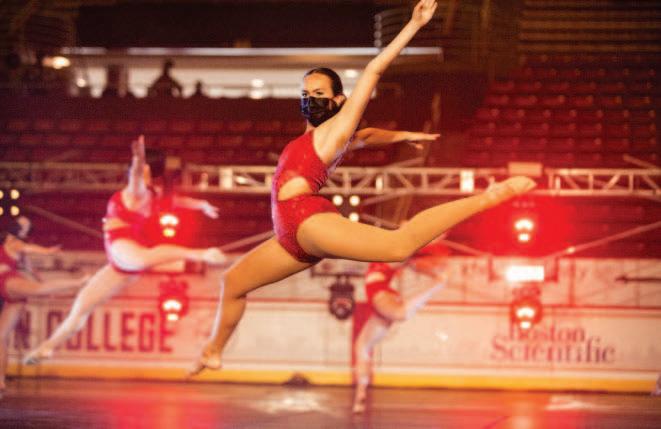
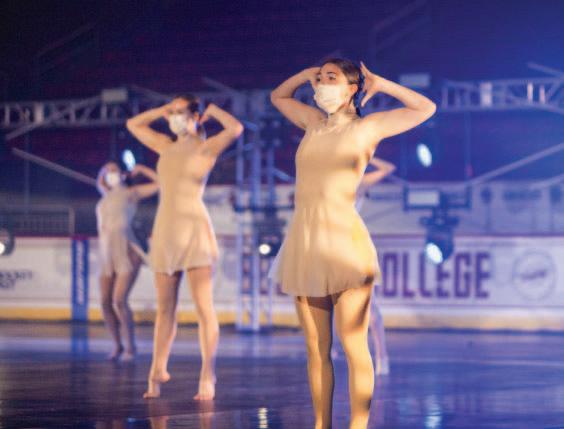
But, nearly a month after the AHANA+ Leadership Council (ALC) spoke about plans to hold a modified Showdown, the ALC announced on Thursday that it was canceling the dance event. ALC decided to call off Showdown due to racially biased events that have taken place on BC’s campus this semester as well as challenges dance teams have faced due to the COVID-19 pandemic.
In place of the event, the Office of Student Involvement (OSI) offered dance groups hour-long practice time slots in Conte Forum on Sunday. Synergy Hip Hop Dance Company, On Tap, Full Swing, Masti, Boston College Dance Ensemble (BCDE), Dance Organization of Boston College (DOBC), Phaymus Dance Entertainment, UPrising Dance Crew, PATU, and Boston College Irish Dance all took advantage of the practice times. Each group signed up for individual time slots to perform for an empty arena—a stark change from the packed crowds that usually fill Conte for Showdown in past years.
But UPrising creative director Andrew Cho, MCAS ’22, said the recent changes did not impact his dance group’s plans. The group chose to use the stage in Conte as an opportunity to perform one last time together before the school year ends. For its Showdown set, Cho said UPrising traded in its typical high-energy dance set and instead focused on conveying a message of how social media negatively impacts relationships through its choreography.
Aided by a videographer, Cho said
UPrising will release a video of the group’s Showdown performance the first week in May during the group’s “Waves Week,” which will include five days’ worth of pre-recorded video performances by the group. UPrising plans to release the Showdown performance video on its YouTube channel, Cho said.
Inside Conte, black flooring sprawled across the middle of the arena, allowing dancers to practice socially distanced. Elaborate lighting rigs dangled from the ceiling to light up the stage. Spotlights spun around the stage and colorful geometric lights flashed as the dancers took turns performing on the stage. Unique compilations of songs reverberated through the empty arena, as a lighting and sound crew watched over the performances and helped dance groups set up the lights and sound system.
After preparing its dance for over a month, Masti took the stage at noon to record its performance. The group danced to a compilation of songs, including the chart-topping “drivers license” by Olivia Rodrigo. Inspired by The Avengers franchise, Masti incorporated traditional Bollywood into its superhero-themed, storyline-driven choreography through Bhangra props called saaps and khundas.
Masti captain Tanya Walia, MCAS ’21, said the group was looking forward to the livestreamed event previously planned, and was initially disappointed by ALC’s decision to cancel the event. But, Walia and her co-captains, Divya Kumar, MCAS ’23, and Muskan Merani, Lynch ’23, said that the team stands by ALC’s decision.
As a senior, Walia said she was excited to be able to perform one final time after being part of the team for the past four years.
“It was really a lot more than I could have expected for like senior year in a pandemic to be able to still perform as much as we did, and like an event like this,” Walia said. “So I’m really happy with that.”
Throughout its session, the Masti dancers hurried off the stage to get a drink of water but quickly ran back to their positions, taking advantage of every minute they had on the stage. After its set, the team gathered in the middle to do a final cheer.
The team arranged for a videographer to record its performance and is planning to post the video on its social media accounts, Kumar said.
Next to take the stage was BCDE. The group utilized its practice time to record its three performances. Each performance had its own costume change and was set to its own song, with dance genres ranging from jazz to hip-hop to contemporary modern. Although the dancers had to spread out, they took advantage of the entire makeshift stage, constantly moving and weaving through the space to create dynamic, fluid formations.
“The set … was supposed to be our last year Showdown set, but we had all been really excited about it, and so we decided to still do it this year when we found out that showdown was going to be put on again,” BCDE director Caroline Melvin, MCAS ’21, said.
The group’s performance focused on female empowerment, challenging societal beauty expectations and advocating for body positivity. BCDE assistant director Isabel Garber, Lynch ’21, said the songs in the set were meant to build upon each other to encourage self-love and self-acceptance. While the group expressed its dis-
appointment over the lack of a regular showcase, BCDE also recognized why ALC decided not to sponsor the event this year.
“We love Showdown,” BCDE costume designer Margarett Burke, Lynch ’22, said. “It’s one of our favorite BC traditions … [but] we completely understand why it was canceled this year and support ALC’s decision.”
Although 10 dance groups took advantage of these practice times to film Showdown performances, some dance groups, including Fuego del Corazon, decided not to participate.
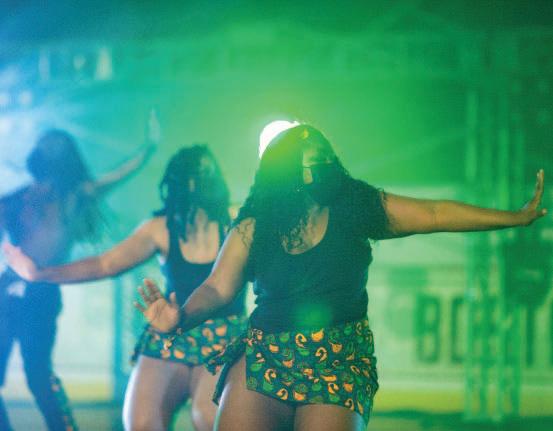
“If only we just had a word of what would be the plan by like January, instead of like March, we would have probably been in a better position to stay in the event, even if it wasn’t a livestream,” Fuego co-captain Arturo Balaguer Townsend, MCAS ’21, said.
In a normal year, Townsend said Fuego would practice three times a week and even ramp up its hours as the showcase approached. In preparation for Showdown, the group would often begin preparing sets three months in advance. According to Townsend, this year dance teams were only informed Showdown would take place about a month before the event was set to occur and restrictions on Brighton Dance
Studio greatly cut the teams’ practice times. Even with these changes, Townsend said the group was initially planning to participate in Showdown. But he said when it began to seem like ALC and OSI were uncertain of their plans, he said the group’s motivation to participate began to dwindle.
“[ALC and OSI] started to sort of fall back,” Townsend said. “And that just honestly gave us like a little bit of discouragement, because, you know, we were working hard to like work every single hour we could.”
In addition to Showdown, Townsend said Fuego had another performance planned with the BC bOp!, BC’s Jazz Ensemble. The team recorded a set to a song by BC bOp!, and the band will livestream its performance in conjunction with Fuego’s recording. Townsend said Fuego’s decision not to participate in Showdown was motivated by both the group’s concerns regarding the new format after ALC withdrew from the event as well as the team’s decision to focus on the BC bOp! set.
“We’re just going to want to end the semester on a good note,” Townsend said. “It’s very important for the team to make sure that everybody feels sort of good about being on the team, everybody feels like not overworked, everybody feels loved.”
Jasen: The Lost Appreciation of the Vinyl Record
 BY LAUREN JASEN Heights Staff
BY LAUREN JASEN Heights Staff
I have been a lifelong admirer of analog music. My love for this kind of music was inspired by my dad, who started his vinyl collection back in ’73 when he bought Al Green’s Call Me album—a personal favorite of mine. He still has it to this day, and we must have listened to it hundreds of times by now. The cover is completely worn out and the years have left a few scuffs and scratches on the legendary disc, but we don’t mind the record’s imperfections that have accumulated with time.
Given my longtime affinity for music, particularly records, I decided it was time that I venture to Allston to explore one of Boston’s hidden gems— Looney Tunes Record Store. I walked downstairs and opened the door to find a room full of stacks upon stacks of vinyl albums, cassette tapes, books, films, and guitars. Scanning beyond the piles of records, the walls are lined with a series of posters, ranging from Muhammad Ali to Louis Armstrong to Jimi Hendrix. George Harrison’s “Living In The Material World” played in the background, and met with this sensory overload, I had never seen anything like it before.
Pat McGrath, a man who claims he has been willed into existence by music, is the proud owner of this house of music. The store was originally located
on Boylston St. for over three decades, but it recently moved to Harvard Ave. in the last few years. McGrath said he has a simple approach to the records business: If it moves you, it’s yours.
There is something particularly nostalgic about walking into an old record shop and embarking on the search for the needle in a haystack you’ve been hoping to add to your collection. The exquisite artwork on the sleeves of the disks makes you feel like you are walking around a museum. Walking into a store like this, where there are albums both old and new, you inevitably take on the role of an archeologist carefully searching through stacks of records. It is an extraordinary experience to imagine who owned a particular album at one time— and to think about how that record may have inspired a previous owner at some point or another.
Looney Tunes is a place of stories. A constant stream of stories from some of the most brilliant writers of
our time come through the speakers as the store’s visitors converse with one another over records. McGrath, who described listening to a vinyl album as a sort of “religious experience,” has a unique way of making people want to share their stories. I would guess that
in as you slowly take the disc out of the sleeve, blow the dust off the needle, carefully place the record on the turntable, and read the lyrics on the jacket cover like poetry while listening to the splendid sound coming from the speakers. McGrath said this is an experience
Technology has clearly driven the masses toward convenience as we have moved from albums to tapes to compact discs to streaming services. During this progression, we have also lost this brilliant opportunity to sit and listen to an album from beginning to end and witness the vivid poetry the author has created for us.
Listening to music in a digital format is the equivalent to only reading the first few chapters of a book. It doesn’t tell the full story. The imperfections of the individual records mirror the imperfections of life. There are scratches on tapes just as there are challenges in life.
leaves as a friend. Shops like this do an incredible thing by bringing strangers scattered around town together and uniting them through their love for music.
There is a certain warmth and richness to a vinyl album that cannot be replicated. The experience of listening to a vinyl is not solely for the music elitists. Listening to one becomes a sensory experience anyone can engage
ness. They either come in search of the perfect album to add to their extensive collections or they just pop in for a chat about the wonders of music and of life. Then there are the newcomers, the vinyl novices who immediately head toward the classics as they begin their collections. They’ll go for The Beatles’
No two albums are identical, just as no two people are exactly the same. It isn’t that vinyl enthusiasts resist contemporary technology, they just have a greater appreciation for the genuine sound of an album and the magical experience of shopping in a store like Looney Tunes.
As I took the T back to campus, I looked around at the people sitting near me and I realized this crowded train car is a lot like the shop, each of us packed in like the albums on the shelves.
Everyone has a unique story to tell,
just have to put it on the turntable and give it a listen to find out what it is.
GRACE MAYER Arts Editor
A5 THE HEIGHTS MONDAY, APRIL 26, 2021
Dancers Perform Despite Showdown Cancellation
Abbey Road, U2’s The Joshua Tree, Pink Floyd’s The Dark Side of the Moon Fleetwood Mac’s Rumors, and Nirvana’s Nevermind
c about g the ng isite artk he ves es you ike are ing nd uinto re like where there i it bl t k the role
everyone who comes into Looney Tunes asa that “nurtures the soul.” Part
ulars,
pa thi br an wi cr fo th do tio th sc ch no isn te a so
you
almost
of what makes record shops special is the characters that come into them day to day. There are the reg-
the vinyl devotees that keep places like this in busi-
IKRAM ALI / HEIGHTS EDITOR
Boston College Dance Ensemble’s performance channeled a theme of female empowerment.
IKRAM ALI / HEIGHTS EDITOR
Using the stage in Conte Forum, the Boston College Dance Ensemble performed a set with costume changes.
MEEGAN MINAHAN / HEIGHTS EDITOR
IKRAM ALI / HEIGHTS EDITOR
PATU danced in patterned costumes to high-energy choreography that included traditional step.
By Anna Lonnquist Magazine Editor Stephen Bradley Assoc. Magazine Editor MC Claverie Asst. Magazine Editor
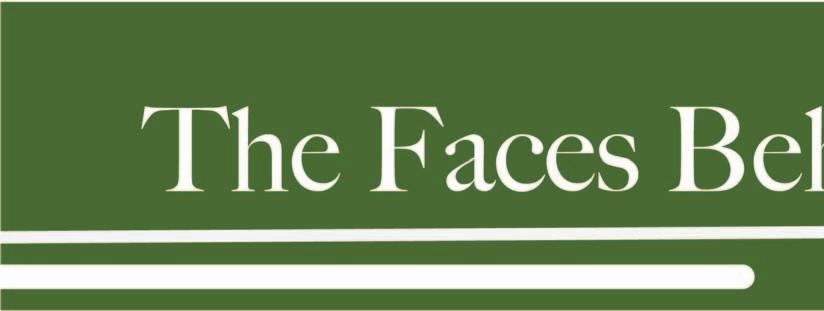
Boston College students have struggled this academic year through the lack of breaks, restrictions on gatherings, and the loss of traditions that are integral to the BC experience. Several aspects of campus life have been altered, but one thing remained constant—the dedication of BC’s essential employees.
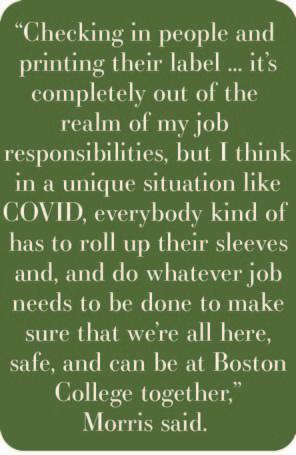
Through the fluctuating COVID-19 protocols, BC’s essential workers— from dining services to COVID-19 testing to custodial services—have been crucial to ensuring that the BC community remains safe, while trying their best to preserve a sense of normalcy on campus.
In early March last year, students returned from Spring Break to preliminary protocol changes in response to COVID-19. BC Dining was forced to adapt quickly as the CDC continually released new information.
The elimination of self-serve food stations was one of the first changes students witnessed, but it certainly wasn’t the last. When the majority of the student body evacuated by March 15, there were approximately 500 students remaining on campus through the end of the semester. BC Dining’s biggest challenge was trying to keep students and employees safe while getting students fed, according to Ryan Palanza, assistant manager of BC Dining Services at McElroy Commons.
For custodial staff, there was disorder in the wake of the move-out week. Taking care of the belongings students left behind often fell to the custodial staff, custodian Sherrise Trim said.
When the students remaining on campus were moved to Upper Campus, custodian Elisabeth Figueiredo and other custodians were
charged with anxious uncertainty about what the future would hold, Figueiredo said, but even so, the work of custodians and BC Dining workers never stopped.
“We’ve been doing a lot. We haven’t stopped [in]… over a year,” Trim said. “We haven’t stopped since March. … It’s, like, an ongoing thing. Gotta keep going.”
Custodian Noel Mathias said he was committed to doing what was needed and continuing the cleaning work that he was already so accustomed to.
“[It was] different but the same thing,” Mathias said. “Cleaning is cleaning.”
While COVID-19’s rapid escalation last spring necessitated a quick response from BC’s essential workers, the difficulties of the quick transition had a silver lining—they were helpful in preparing for the 2020-21 academic year.
“Right at the end of the semester, we learned so much about how we could make this whole school year work, so it was kind of a trial run for this year,” Palanza said.
The learning curve did not stop last spring, though.
Over the summer, BC administration and UHS prepared for students to return to campus in August. Knowing that requiring COVID-19 testing for the student body and faculty was going to be vital to remaining on campus for the entire semester, employees in athletics and human resources were tasked with helping to fill these essential roles.
Associate Athletics Director for Marketing and Fan Engagement Jamie
[in] Conte Forum when it was the return to campus in the winter or the startup in the fall ... over at Connell, so it just was a natural fit.”
Employees were quick to embrace this new role in the fall, Jade Morris, senior associate director for student athlete development, said.
“It was just kind of understood that this is what we needed to get our feet back under us and be successful,” Morris said. “And it’s gonna require you rolling up your sleeves and doing a little something a little different, so it was just kind of understood, like, ‘Here’s what we need.’”
BC Dining also had to adjust its operations in response to COVID-19 ahead of the fall semester, with changes ranging from the menu to the way in which it serves food.

A team of BC Dining employees held frequent meetings over the summer to figure out how to efficiently serve food to students, according to Marlon Mazier, first cook at McElroy Commons.

“They went over the menus from all the [dining locations] … to choose what were the best menus and come up with a way … to really make the food somewhat similar to what we had and serve it in a timely manner,” Mazier said.
Upon returning to campus this fall, students adjusted to the new normal—masks, social distancing, and COVID-19 tests became a part of their weekly routines. Employees who shifted roles to help out in COVID-19 testing had to balance their new role with their typical job responsibilities.
For Di Loreto, his experience working in athletics helped with the unknown nature of COVID-19, he said.
“I think the hardest part is the unknown, and the days are usually [unknown] within athletics, we work a lot at nights and weekends so we’re used to it,” he said. “It was still, you know, how do we facilitate and operate and run, and it was just curveballs and challenges, constantly, logistically … it was very difficult to plan for anything and the unknown and the unplanned was normal, very normal.”
COVID-19 testers originally worked one full-day shift per week at the beginning of the fall semester. Eventually, their schedules were cut down to a half shift a week, which is about four to five hours, Di Loreto said.
Their responsibilities vary from checking in students and staff at the door or checking them in at a laptop and printing out their label, Morris said.
students and colleagues, Di Loreto said.
“It’s very special when … you have this really week-to-week connection with certain people [that] were coming in,” Di Loreto said. “Your odds of getting them were one in five but one of the tables, but I would see the same people. … We haven’t seen a lot of our colleagues around campus so the one place I could really feel that I could see people was … over there with the testing.”
Because of the repetitive nature of their work, incorporating creative ways to keep from becoming fatigued has been important, he said.
“It’s very repetitive so if you don’t get creative with the way you’re doing things I think it could really I think start to burn people out,” Di Loreto said. “Our field definitely is like, ‘How do we have fun with this? How do we connect with people?’ and … for us it’s very much about customer service, so it was a lot of fun doing it.”
For custodial staff, the main changes included diligence about wearing masks and gloves, as well as increased cleaning
implemented by department management was the designation o f a new closet for his cleaning supplies since his previous one was next to the COVID-19 holding rooms within UHS. Half of Anacleto’s supplies went into this new closet, helping him maintain distance from symptomatic students, which helped him continue feeling safe, he said.
“When it was getting busy, I would have no business being down there because I can get all my supplies from the other side,” Anacleto said. “The communication was good … they let us know if [the students] were negative or positive, so you know how to handle it.”
Despite the unprecedented nature of adapting the University to a pandemic, Figueiredo said that she is pleased with the University’s efforts.
“It’s been an experience … dealing with something that no one’s dealt with, but we’ve gone through it,” Figueiredo said. “BC’s been there the whole entire time just trying to do the best they possibly can.”
In previous years, BC Dining offered students self-serve
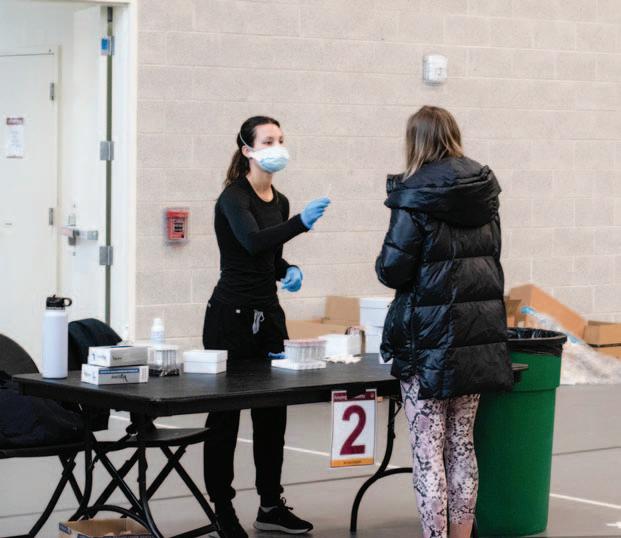
assigned to keep these dorms as clean as possible. During a typical eighthour shift, Figueiredo would cycle through all Upper residence halls three or four times, she said.
Custodian Derrick Anacleto works in 2150 Commonwealth Ave., as well as University Health Services (UHS). As BC began to see its first cases of COVID-19 among students still on
Starting
“Checking in people and printing their label … it’s completely out of like the realm of my job responsibilities, but I think in a unique situation like COVID, everybody kind of has to roll up their sleeves and do whatever job needs to be done to make sure that we’re all here, safe, and can be at Boston College together,” Morris said.
Although working in COVID-19 testing increased their workload, it
protocols in certain areas, according to Mathias.
“Whenever you see someone, it’s hard to recognize because of the mask,” Mathias said. “But the job is the same thing … [with] disinfecting. Everything else is the same thing … the thing is that there’s more disinfecting.”
For Anacleto, working in UHS—where he is in close contact with symptomatic students—also necessitated an increased diligence, he said. Additionally, wearing a mask while doing physical labor and being increasingly cautious of his surroundings made the work more difficult, he said.
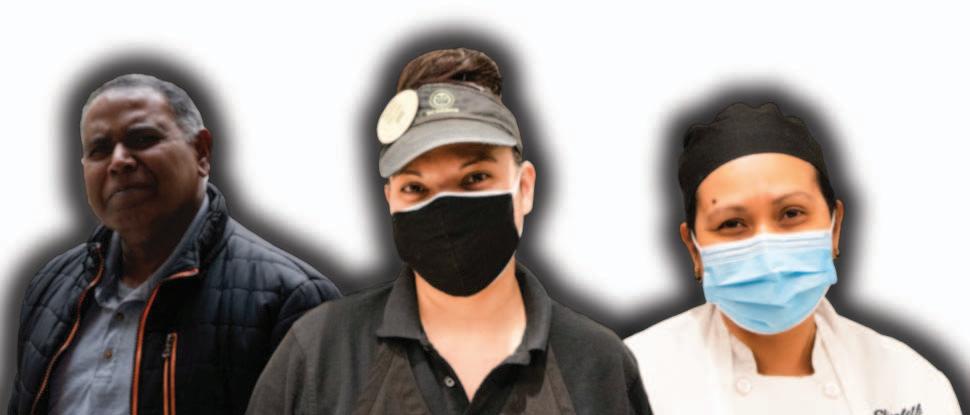
Another difficulty stems from hearing that members of custodial staff have tested positive.
“I would say that would probably be the hardest part is wondering, ‘Well, how did they get it?’” Figueiredo said. “It gets into your head.”
The custodial department has implemented a number of changes to both keep students safe and help employees feel safe.
Among the changes was the hiring of additional staff who work from 5 p.m. to 10 p.m., spraying high-touch surfaces around campus so that other custodians can focus on being thorough with their usual tasks, Trim said.
After her 7 a.m. to 3 p.m. shift,
options and students could roam between stations, creating a closel y packed environment. BC Dinin g has responded to COVID-19 b y implementing stationed lines, having less food options, and limiting contact with employees—all to ensure the safety of the students.
“Things used to be a little more exciting because you could wander around wherever you wanted, no w you have to stay in your lane … I think the quality of the food is the same, but there used to be more variety,” Palanza said.
Mazier said the changes to the menu and the way in which the y serve the food posed challenges, especially because a lot of the food was previously cooked to order, he said.
Mazier is in charge of breakfast and lunch, coordinating menus, and delegating the work. In order to limit the time students spent getting their food and ensure social distancing, BC Dining had to rearrange the menus, Mazier said.
“It’s difficult because, at first, we were not sure [what the students] were gonna like, how they were gonna take it, what was gonna be the bi g hit,” Mazier said. “So, it was a lot o f guessing and waiting to see. So, what we were doing management wise … [was] looking at the numbers week to week and writing down in a diagram,
THE HEIGHTS A9
Di Loreto, has worked in BC Athletics for the past 28 years. Typically, his job consists of promoting the 31 varsity sports, overseeing and coordinating corporate sponsorships for athletics, and advertising BC sports and game day experiences, he said.
in August, like many members of the BC Athletics team, Di Loreto’s job expanded to include
Dining’s operational changes, several
A6 MONDAY, APRIL 26, 2021
NICOLE VAGRA / HEIGHTS STAFF
BC has
Over
the course of the year,
increased
the frequency of COVID-19 testing.
VIKRUM SINGH / HEIGHTS EDITOR
unce ade it unsettling so let o st t ch s lude t time period in August when they wer e looking for who could assist,” he said. “We were already here in the facilities managing a lot of the operations that were taking place whether being workloa provid ed d a n ew way to connect w nacleto change not getting all t goes to wast
cha em ha a PHOTO B O BY JAC AC MI K LL LL LER ER ER / HE EI H IGH G IG I S TS ENIOR STTA FF PHOTOBY JAC JA KMMILLER LE /H HEIGH HTSS TS ENIORSTTAAFF FAF OBY KMI ILLER LE /HEIGH GHTSS RSTAFF FF
In contrast to past years, students must remain distanced and stay in one line.
As Dinin
“Everyone’s position here has really just changed, … which is good, you know, because we’re all now j ust working together. … Everyone’s playing a part in different parts,” Alexander Orrego, utility worker for BC Dining at McElroy Commons, said.
Orrego picked up more tasks in the transition to this year. Previously, he was a utility worker—he washed dishes, took out trash, and sorted things out for chefs and cooks, he said. With the increase in popularity of GET Mobile last semester, his workload expanded—he now makes orders, prints order slips, and distributes prepared orders.
“[Running GET Mobile] was just my new thing now, so now I’m … the GET Mobile guy now, you know, not j ust a utility worker,” Orrego said.
Though BC previously used GET Mobile, it was limited to CoRo Café, which is student run, so dining staff had little experience with it, and none to the massive scale that it had to adapt to this year.
For upperclassmen, the old Eagle’s Nest and its lengthy lines may seem like a distant memory.

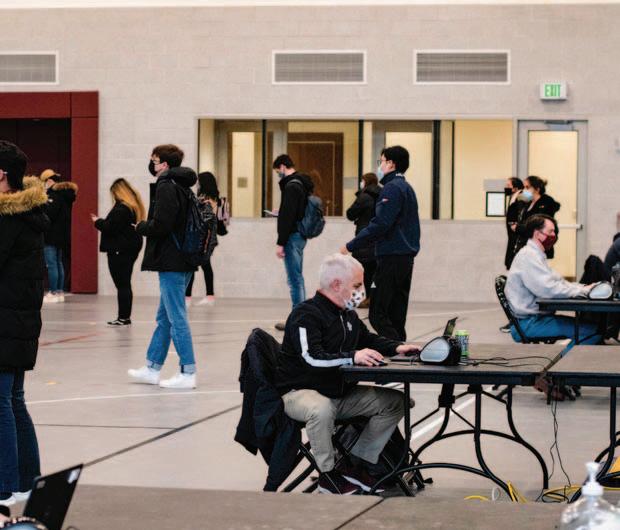
“I used to work in Eagle’s Nest working the salad line,” Palanzo said. “I’d be down there banging out salads, laughing and joking with people, but you don’t really have time to do that now.”
off … and then it was just more like, ‘Alright, now we have to move to operate smoothly,’” he said.
Despite many missing the old atmosphere of Eagle’s Nest, Palanza said that many have recognized the convenience of ordering ahead with GET Mobile.
“It’s almost like a sign of the times,” Palanza said. “People wanna order something— Dunkin’ Donuts, Starbucks, you pick it up—some people like that.”
Several BC Dining employees said that one of the most difficult aspects of the transition to their work during COVID-19 was the lack of interaction between coworkers and students.
“It’s very different now,” Ann Hewson, who works as a cashier for BC Dining Services at McElroy Commons, said. “We’re surrounded by Plexiglas—we can’t really chat with
Despite constraints on their own functions, Palanza noted that he was most proud of BC Dining’s continued commitment to serving the community. Last summer, it donated thousands of meals a week to local shelters, and began a program called Curbside for a Cause. Community members could pay $22 to receive a large amount of food that could feed over four people, which became a huge hit throughout the summer, he said.
“We were not only helping keep our employees employed, but we were also helping out charity institutions,” Palanza said.
Just as University administrators are continually monitoring and responding to new data about COVID-19, BC Dining has paid attention to what students are enjoying, Mazier said.
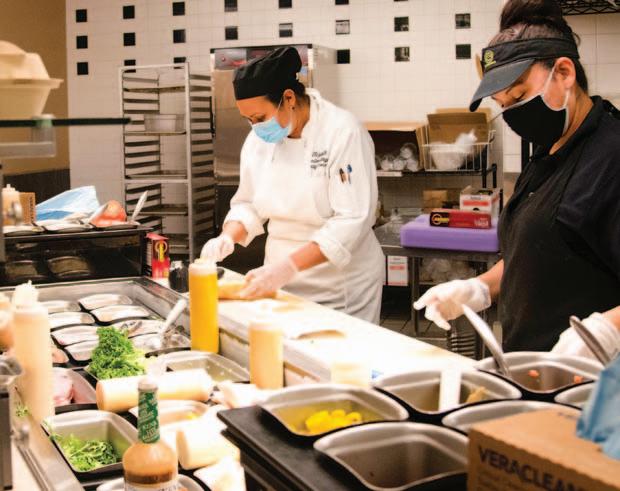
“It’s like with the virus … every week they come out with something different,” Mazier said. “Every week we got to adapt to something different, … like menus. We started looking like, ‘Okay, this doesn’t sell, this doesn’t sell, this … takes a long time to serve,’ so we have to come up with a different way to present the food.’”
Across departments, employees have learned to adapt to this year’s new reality. What was daunting last March now just seems commonplace, Figueiredo said.
“The biggest transition was [from] when this first started to now,” Figueiredo said. “I mean, now it’s like, a norm, but when it first started, I mean, the scariness of it.”
Even in the difficult moments, it’s important to remember that everything will pass eventually, Una O’Hanlon, who works as a cashier in line for BC Dining at McElroy Commons, said, although the lessons they impart will not.
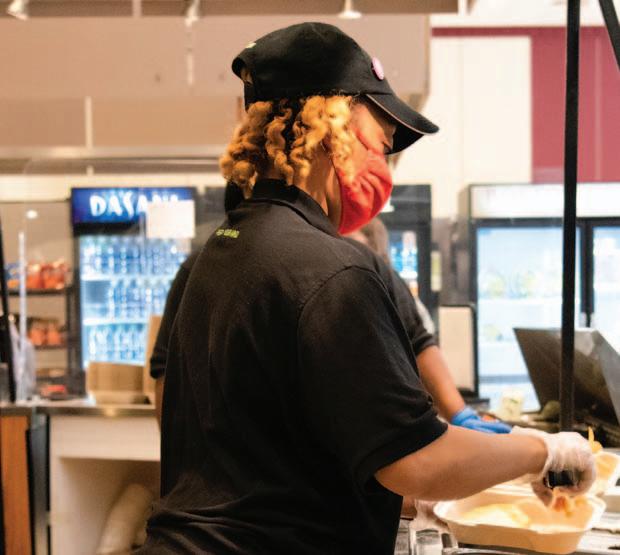
“I think it makes your character stronger to get through this,” O’Hanlon said. “I admire the freshmen … to think they came in as high schoolers and now … then you grew up a lot in that year. And then you’ll never forget these times, but I’m happy that you will have the experience that you should have.”
Though the growing pains of transition were felt across campus by students and staff alike, custodial workers said they appreciate the gratitude they receive from students, Figueiredo said.
“I was just actually saying this to someone over at Keyes. … I said to her, ‘You have the nicest girls,’” Figueiredo said. “I mean, they’re always saying thank you … always, ‘Thanks for your hard work,’ and [we’re] always being acknowledged.”
Although Figueiredo predominantly works in academic buildings, whenever she is working in the dorms, residents frequently thank her, which feels rewarding, she said.

Trim agreed that the gratitude students express goes a long way.
Alongside students’ recognition of custodial staff’s hard work, Anacleto mentioned how his superiors have worked to show their appreciation through things like giving out sweatshirts and hosting lunches where employees are praised, but said that he hopes for some financial compensation for their constant work. Trim echoed this desire for a monetary reward for custodians’ tireless grind.
“This is our second home here today,” Trim said. “We just would like to see the appreciation because we never stopped … we’ve been here since last March.”
Similarly, dining employees appreciate the interactions they still have with students, although they are more limited than in years past.
Students don’t hesitate to express their gratitude for dining employees and have adapted graciously to the new COVID-19 protocols, Hewson said.
“Students have always been appreciative,” Hewson said. “I’ve always found them very nice, very
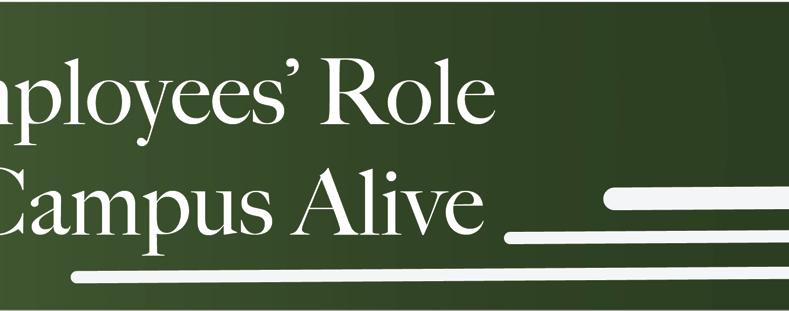
minutes as part of their day,” Di Loreto said. “I just found the students to be so kind and genuine and it’s great to connect with them.”
Anacleto also emphasized the crucial role UHS played in keeping the University functioning during the pandemic.
“I believe that they don’t … [always] get enough recognition for what they do,” Anacleto said. “I see them the way they work with the kids … if there’s any fear in them, it definitely will go away because it’s so pleasant. It’s so nice. And they go the extra mile when not in professionalism and you know.”
Across BC’s campus, these faces and many more have worked to keep students not only safe, but also, to the best of their ability, happy and comfortable.
Despite the strain COVID-19 places on the already demanding roles of these employees, Mazier said that he strives to fulfill his role as best he can every day.

“Everyday, I walk in here with the best attitude I have, and I think that’s the key point … with anything
Orrego said that he began working the GET Mobile lines because it was somewhat new for BC Dining. When GET got up and running last semester in CoRo Café, Orrego said it was frequently busy and that it was short-staffed. It then moved down to Eagle’s Nest, and Orrego organized the meals, set up tables with different pick-up times, and put the orders in alphabetical order.
“We had nothing to go
the students like we used to. … It’s very hard to have a conversation, so I miss that side of it. I miss, like, the connection that we used to make.
Now, we always say hi, and [we] are more friendly, but to have a little chat, it’s … more difficult.”
“They will stop and tell you, you know, they appreciate it, ‘thank you for doing what you’re doing,’” Trim said. “[It] makes you feel really good.”
thankful, and I think they have adapted very well because now everybody comes in, and they sanitize their hands, and they have to stand six feet apart.”
The extra efforts students undertake to show their appreciation for dining staff does not go unnoticed, Orrego said.
“I know we all do feel appreciated here because even, you know, like on the GET Mobile [app], [students will] put little instructions, and they’ll, you know, they’ll add little notes like, ‘Oh we appreciate everything that you guys do here,’ so that’s really good,” Orrego said.
Orrego said this recognition from the student body is what helps maintain BC Dining employees’ morale.
“We do our part by feeding, you know, students, and then they do what they can, what they can only do, and, like, just leave little notes to pick us up and, like, make us feel good, … which definitely keeps us going, and that’s our fuel,” he said.
Those working in COVID-19 testing also said they felt appreciated by students’ graciousness.
“One thing I really would highlight that we talk about a lot is how kind and caring the BC students are just in general and have the connection and appreciation they show that they do understand even if they may be seeing you for a quick couple
you do in life,” Mazier said. “If you go into something with a good attitude, get up every day and have a good attitude that everything’s gonna be okay, everything works out. You make it work.”
While the challenges presented by the pandemic have been burdensome, they have also highlighted how important each job is to keeping BC running.
“It feels good because … there’s other people on the front lines … like the health care workers, but then, we’re on the front lines of this part, so I feel like we definitely play a major impact in people’s lives and trying to get them fed and make sure everybody’s eating good, you know, because that’s the fuel to keep the body going,” Orrego said.
After over a year of continual adaptation in order to preserve a safe campus for students, Figueiredo said that her main takeaway from the pandemic has been to practice gratitude.
“I hope the lesson is that we don’t take things for granted anymore and we learn … how important it is to appreciate who’s around us and what’s around us,” Figueiredo said.
THE HEIGHTS A9
A7 MONDAY, APRIL 26, 2021
Testing lines are set up each week in the Margot Connell Recreation Center.
Employees in Eagle’s Nest prepare sandwiches ordered on GET Mobile.
VIKRUM SINGH / HEIGHTS EDITOR
PHOTOS BY VIKRUM SINGH / HEIGHTS EDITOR AND NICOLE VAGRA / HEIGHTS STAFF
NICOLE VAGRA / HEIGHTS STAFF
F
GRAPHICS BY OLIVIA CHARBONNEAU / HEIGHTS EDITOR
NICOLE VAGRA / HEIGHTS STAFF
Employees serve students at McElroy Commons behind masks and Plexiglas.
Boston College Should Expand Core Renewal Courses to All Students
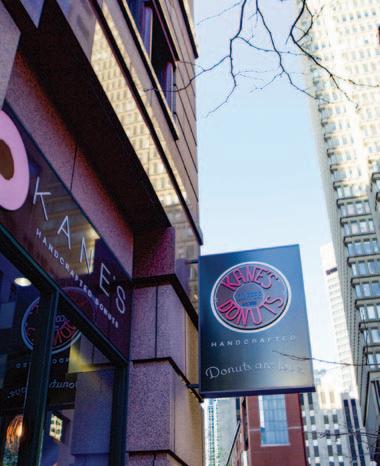
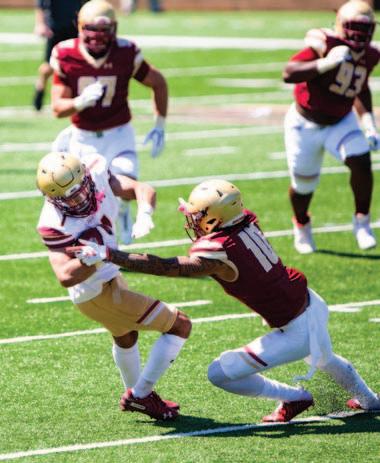
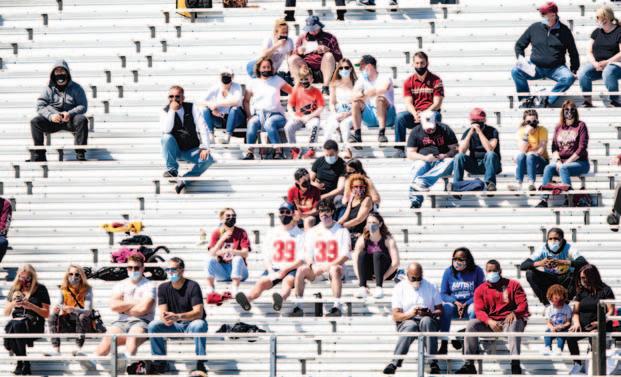
Boston College should expand access to interdisciplinary Core Renewal courses beyond first-year students in order to keep upperclassmen engaged in the core curriculum.
BC’s process of revamping its core curriculum began in 2012 and was most notably marked by the creation of the Core Renewal Enduring Questions and Complex Problems classes for first-year students. These classes are team taught by two professors and aim to create an interdisciplinary approach to exploring important questions and topics.
Enduring Questions and Complex Problems classes are traditionally only open to first-year students. Classes of only freshmen help students feel more comfortable in their courses and bond with one another more, which can facilitate more open discussions in class.
Core Renewal classes have been opened to sophomores in the past, especially when the program was in its pilot phase from 2015 to 2018. When this happened, sophomores registered, which demonstrates that there is interest in these courses among other class years.
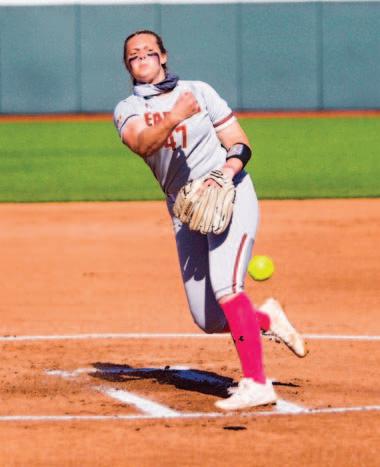
The University should offer similar interdisciplinary classes to upperclassmen. BC’s core curriculum—with 15 core requirements—is relatively large as compared with other liberal arts schools like Northeastern University’s core curriculum of 11 courses and the University of Notre Dame’s 13

Week in Photos
courses. Students in the Morrissey College of Arts and Sciences must also demonstrate intermediate level proficiency in a foreign language. It would take a student starting from scratch four courses to meet this requirement. Students having to budget so many courses into their schedules can make completing the core a challenging process.

BC’s core curriculum is comprehensive, but it would benefit from adding Core Renewal courses for all students. Such interdisciplinary and engaging courses should not be limited just to first-year students. Complex Problems and Enduring Questions courses should continue to exist in their current forms, as separation by class year helps to facilitate comfortable and engaging conversations during class. Freshman-only classes are an extremely valuable experience for BC students and an integral part of the first-year experience. Especially during the pandemic, having engaging, mostly in-person discussions has been extremely beneficial to the freshman learning experience. These formative experiences should not stop after students’ freshman year.
The goal of Core Renewal courses is to tackle multifaceted issues that core classes with a singular focus can miss. They facilitate intersectional and critical thinking, which BC recognizes is an advantage of a liberal arts education. BC’s core curriculum should not be seen as boxes to check
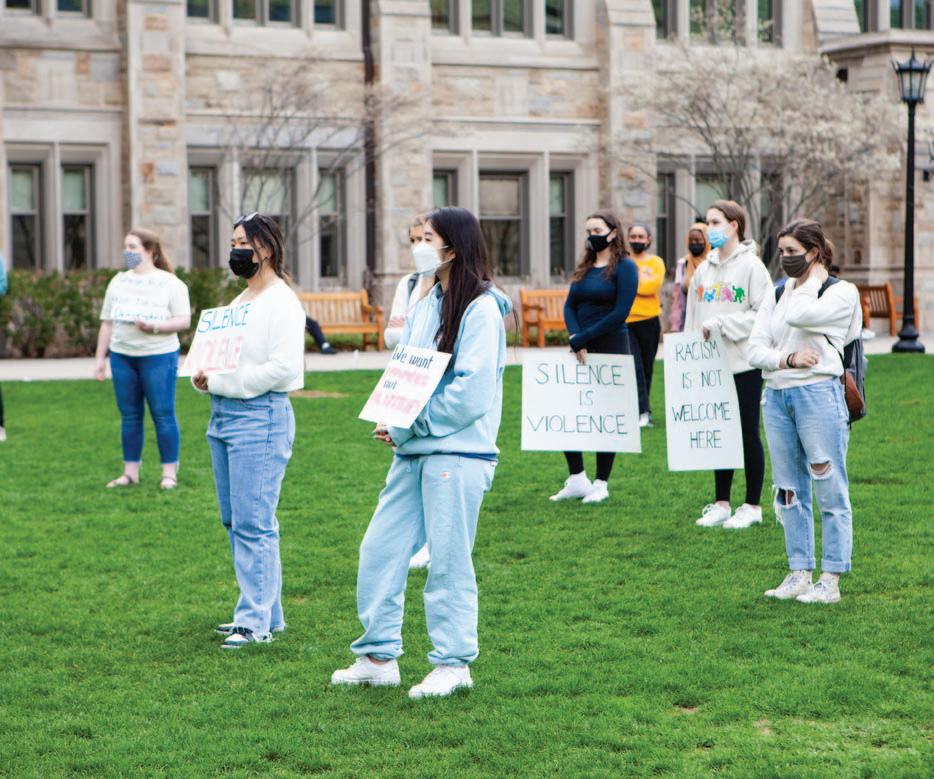
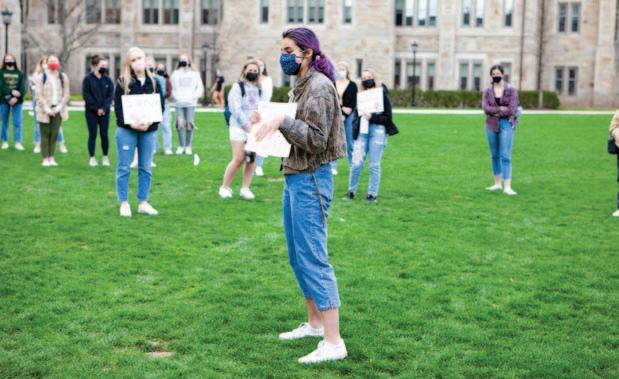
off, and the interdisciplinary, real-world nature of the Core Renewal courses helps students engage in the core in a more meaningful way.
Fulfilling the cultural diversity requirement is especially important, and Core Renewal courses should not act as stepping stones to skip over difficult conversations that this requirement facilitates. Instead, they should provide a focused lens through which cultural diversity and other core requirements can be questioned and discussed.
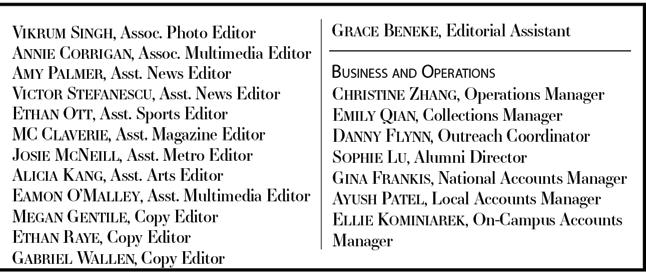
As BC students make their way through their four years, the core can weaken and become a less meaningful component to students’ education. Classes like Perspectives or PULSE offered for freshman and sophomore students are strong ways to complete the philosophy and theology requirements. Upperclassmen do not have intensive courses separated by class year, however, and often end up taking less stimulating classes such as Geoscience and Public Policy—known among students as “Rocks for Jocks”—just to fill their core requirements for graduation.
Throughout their education, BC students should be consistently enrolled in challenging and focused courses that keep them engaged. Complex Problems and Enduring Questions courses have proved their strength, and expanding access to similar Core Renewal courses would be an effective way to keep all students engaged in their education.

THE HEIGHTS A8 MONDAY, APRIL 26, 2021 EDITORIAL
Top photos, left to right: Wide receiver Jaelen Gill attempts to evade defensive back Brandon Sebastian, Saturday, April 24; BC pitcher Peyton Schnackenberg pitches against Pitt, Friday, April 23; A look outside of Blackbird Doughnuts, a shop in Newton Centre, Tuesday, April 20; A look outside of Kane’s Donuts, a shop in Boston, Tuesday, April 20.
Bottom photos, left to right: Family and friends attend the Jay Gillis Memorial Spring Game, Saturday, April 24; Aneesa Wermers, Lynch ’23, speaks to protestors on Stokes Lawn, Monday, April 19; Students and faculty gather to protest racial injustice, Monday, April 19.
(IKRAM ALI / HEIGHTS EDITOR); (ADITYA RAO / HEIGHTS STAFF); (NICOLE VAGRA / HEIGHTS STAFF); (MOLLY BRUNS / HEIGHTS STAFF).
BC’s Response to COVID-19 Is Irresponsible
But there were still myriad issues with BC’s handling of COVID-19 last semester, from the testing program, to outbreaks among students, to the administration’s hand-washing of responsibility. Multiple studies have shown that college reopenings have preceded notable increases in infections in their surrounding communities, and with these increases come more tragic deaths.
and yet made no acknowledgement to students about the case spike. BC did not acknowledge the spike in cases until the associate vice president of student affairs sent an email to students on Sept. 11 reminding them to social distance during the outbreak, which she said was “largely attributable to student interactions within six feet of one another without face coverings.”
When I learned Boston College had made the decision to return for the fall semester in person, while the College of the Holy Cross—where my little sister, Lizzie, is a freshman—decided to go virtual, I felt two emotions. The first was gratitude that I could return to Boston to spend my last two semesters in person with my friends, and the second was empathy for my sister and the reality that she wouldn’t have a traditional freshman year.
I caught up with my sister a couple weeks into this semester to check in on her, and during the course of our conversation I inquired about Holy Cross’ COVID-19 policies. Lizzie mentioned that, now in-person, Holy Cross was testing its students for COVID-19 twice a week—a policy that might seem standard but which brought back memories of the blowback BC faced from students in the fall for inadequate testing.
Back around the time BC was facing substantial criticism over the outbreaks of COVID-19 on campus in September, I remember going weeks at a time without being called in for testing and going without recourse to voluntarily receive a COVID-19 test on campus. That same month, a friend of mine who came into contact with someone who later tested positive had to borrow my car to drive to get tested off campus after being refused a test at BC because the contact was more than 48 hours before symptoms began.
To be fair, BC has amended its testing policies since the beginning of the fall semester to test students at a more consistent rate, but many students still are only tested once per week. The COVID-19 situation at Holy Cross is nonetheless troubling, with a positivity rate of .27 percent this semester— lower than BC’s .41 percent, even as Holy Cross tests its students more often than BC.
A total of 214 people have died from COVID-19 in Newton, which is 1.24 percent of COVID-19 deaths in Massachusetts. This rate is proportional to the rest of Massachusetts, as Newton’s total population is 1.29 percent of the population of Massachusetts.
BC had a responsibility to its students and the surrounding community to do everything it could to mitigate cases on campus. If the only way to do so was to remain online, I would be devastated for the loss of my senior year, but that doesn’t even approach the devastation of losing a loved one to COVID-19.

This is why I get such a bad taste in my mouth when I read comments on Heights articles lashing out against any criticism of BC’s response, or when I read an opinion from The Heights Editorial Board lauding the completion of the fall semester as “a testament to University’s planning, leadership.”




No, simply managing to ride out the semester in person does not qualify as a “successful fall semester.” Not sending students home and minimally adapting policies based on criticism is a remarkably low bar.

Massachusetts data from Dec. 22, at the end of BC’s fall semester, shows that 8 percent of cases in Massachusetts higher education came from BC. In comparison, 8.87 percent of the Commonwealth’s cases came from UMass Amherst and 10.9 percent of cases came from Northeastern University, both of which have significantly more students than BC.
When 73 BC undergraduates tested positive in the second week of the fall semester, BC faced a torrent of criticism from students, local officials, and the media. Between Aug. 31 and Sept. 13— amid the spike—BC reported 99 cases on campus
Not once has the University accepted any blame for the outbreaks. The administration did, however, have no issue blaming students or local and national infection trends—alternatives it seemed to pick depending on which seemed more plausible at the time.
Contrast this with Holy Cross’ response this semester when it received more than 40 positive tests among undergraduates in early April: It amended its policies based on its campus alert level guidelines (which BC does not have) until cases fell again, rather than blaming students for a lapse in compliance. Even this bare-minimum level of responsibility is antithetical to BC. Even as cases this semester rose past the level that sparked widespread concern and policy changes in the fall—with a total of 95 cases the week of Feb. 8 to Feb. 14 and 85 cases the week of Feb. 15 to Feb. 21—BC has done practically nothing in response.
Months later, BC still hasn’t fully gotten its act together. Cases remain high this semester—with a community positivity rate of .41 percent—which research shows reverberates around the local community. Students are permitted to go out to eat off campus, which many take as an invitation to gather at local bars, and the dining halls consistently feature mid-sized groups of students without wearing masks even when not eating. I love BC and am immensely grateful for an in-person senior year, but BC owed me, my classmates, and the community more than its profoundly negligent response.
Scott Baker is an op-ed columnist for The Heights. He can be reached at scott.baker@bc.edu.
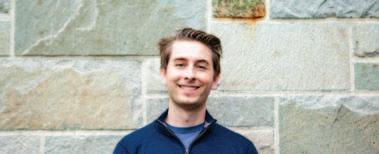
Thursday was the 51st annual Earth Day since 1970. President Joe Biden hosted the Leaders Summit on Climate on Thursday and Friday in order to discuss the urgency and benefits of strong climate action. We only have one Earth—there is no planet B—so taking action and taking care are huge thumbs up.
A Green New Deal Makes Sense

and plummeting food supplies will be those who live in developing nations, mostly in the global south. It is evident that this situation is fundamentally unfair and unsustainable. The question is, what can we do about this moral and environmental crisis?
SOPHIE CARTER
Last Tuesday, U.S.
reintroduce
the ambitious steps to
signature bill, the Green New Deal. With new Democratic control of both houses of Congress and the White House, it appears as though the most sweeping piece of climate legislation in history may have another chance at being passed. If so, it will transform the national economic and environmental landscape. It is well past time for the Democratic Party to uniformly rally around the Green New Deal and work to change the course of climate injustice in America.
As it stands today, climate change is undoubtedly one of the most pressing issues facing the world. There are concerning signs surrounding the prospects for maintaining an inhabitable world—storms and major weather events are worsening, the sea level is rising, and humans have already warmed the globe by about one degree Celsius.
It is also important to note that the effects of the climate and environmental crises are not uniformly felt across all social groups. Declining air and water quality is far more likely to impact racial minorities, especially those who live in urban areas. In the United States, one out of every six Black children suffer from asthma due to poor air quality, and they are five times more likely than white children to contract lead poisoning because they live in close proximity to toxic waste. On a more global scale, the majority of those who will be displaced by rising sea levels, unstable weather events,
The Green New Deal is a piece of public policy that is carefully crafted to address the interrelated crises of environmental degradation and social inequality. Scientists agree that in order to achieve a best-case scenario surrounding the changing climate, the world needs to achieve carbon neutrality by the year 2050. The Green New Deal aims to push the U.S. to take on a leading role in working toward this goal by implementing a 10-year plan that includes investing in the move to 100 percent renewable energy and sustainable infrastructure. All of these goals would be achieved through creating high-paying, green jobs in order to reduce economic inequality and retrain those who work in the dying fossil fuel industry. Although the bill would function as a non-binding resolution, its passage would signal national cohesion on climate-friendly initiatives that are already being implemented at state and local levels.
In addition to being a comprehensive and innovative piece of public policy, the Green New Deal makes economic sense. Climate change is both a threat to our existence and a fantastic opportunity to rebuild our economy in an equitable and sustainable manner. It is helpful to view the Green New Deal as more of an investment than anything else—if Congress is bold in its climate action, it could create an estimated 10.6 million new green jobs, expand job training for skilled laborers, and revitalize the role of unions in protecting American workers. By investing in sustainable infrastructure and labor, sweeping legislation could put millions of people to work with fair wages and jumpstart a post-pandemic economy, functioning to lift people out of poverty and rebuild the middle class. By shrinking income inequality
and the influence of environmental racism, we could make our new green economy open to everyone.
Despite the benefits that would be achieved by addressing economic inequality and climate change, the Green New Deal has become a polarizing force in American politics. The objections to the Green New Deal are largely predictable. Republicans in government decry the so-called presence of socialism, relying on straw man arguments that incite fear around absurdities like the possibility of Democrats banning hamburgers and milkshakes. Moderate Democrats also exhibit reticence towards taking such bold action out of fear of shutting down the possibility of bipartisanship, but these legislators desperately need a reality check. Bipartisan cooperation on climate is a non-starter, and one needs to look no further for evidence than the bad-faith claims by Republicans that “airplanes will be banned” under Democratic climate leadership. Compromise is not likely on this issue, no matter how many concessions Democratic lawmakers make. That is simply a reality that Democrats need to accept, and they should not let this fear of acting in a partisan manner stop them from implementing an economically and environmentally sound piece of legislation.
Incrementalism will inevitably fail to adequately tackle the monumental task of moving the country toward carbon neutrality, and the communities affected by environmental injustice deserve better than baby steps in the right direction. It’s time for the Democratic Party to muster its political courage and continue to shift the way we talk about climate change, inequality, and environmental racism, and the best way to do this is by passing the Green New Deal.
Sophie Carter is an op-ed columnist for The Heights. She can be reached at sophia.carter@bc.edu.
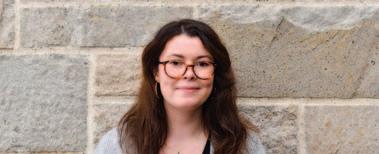
The opinions and commentaries of the op-ed columnists appearing on this page represent the views of the authors of those particular pieces, and not necessarily the views of The Heights
Last Friday, Camp Kesem at Chestnut Hill hosted a fundraiser with Krispy Kreme donuts. Students were encouraged to donate 10 dollars for a dozen Krispy Kreme donuts, which they picked up on Lower for a Friday afternoon snack that supports a great cause.
The Chestnut Hill weather last week was a wild card. BC was served a hefty helping of high winds that did absolutely no good, only aggravating allergies and making walks across campus feel like moving in place.
It might seem obvious, but losing (or misplacing) an Eagle ID is a right of passage that all BC students experience at some point. Whether it’s simply forgetting it in the dorm or losing it mid Spikeball game, the inconvenience is one that every student is familiar with.
THE HEIGHTS
MONDAY, APRIL 26, 2021 A9
SCOTT BAKER Earth Day
Losing an Eagle ID
Camp Kesem Fundraiser
Against the Wind
Representative Alexandria Ocasio-Cortez of New York and Massachusetts’ own U.S. Senator Ed Markey took
formally
their
GRAPHIC BY MEEGAN MINAHAN AND OLIVIA CHARBONNEAU / HEIGHTS EDITORS
The three-page document says that a firearm business, firing range, or gunsmith cannot be located within a radius that is yet to be determined of any residential property line, private or public K-12 school, daycare center, preschool, child care facility, public park, land or structure used for religious purposes, library, another firearm business, firing range, or gunsmith.
The prospective store is located on the same street as Cabot’s Ice Cream and within one mile of Newton North High School, F.A. Day Middle School, Newton Early Childhood Program, Jason Walnut Park, and Horace Mann Elementary Schools.
The amendment also says that no graphic symbols or images of firearms, ammunition, or firearm accessories can be visible from the outside of the firearm business, and that the council may impose additional restrictions on signage to mitigate the impact on the neighborhood.
If a proposed firearm business has not begun operating by the public hearing date of May 10, it will be subject to the zoning amendments when they are passed, according to the FAQ about the ordinance on the Newton government website.
Due to constitutional protections, more restrictive regulations imposed on firearm sales are more likely to
be challenged in court, according to Newton’s website.
“While we are continuing to research all our options, it appears that Constitutional protections would make it legally very difficult, if not impossible, not to identify at least a few locations where such an establishment might seek permission from the City Council to operate,” Fuller said. “I recognize that this will not be an easy conversation for our residents or the City Councilors but it has to be approached in a legally defensible manner.”
Newton’s Inspectional Services Department (ISD) issued a stop work order on Tuesday at 709 Washington St., where the store is set to open, since renovations were being done without the necessary permit, according to Fuller.

The ISD did not receive an application for a building permit or an occupancy permit from the property as of Friday, according to the Newton website. As required by state law, the ISD must process building permits within 30 days of the application filing.
“At this time, a firearms dealer cannot begin operating at this location until these issues are resolved,” the Newton website says. “The business owner must apply for and be issued a building permit, the outstanding building code violations must [be] remedied, and an occupancy permit must be issued before any business can
commence operation.”
Concerned residents created a website, petition, GoFundMe, and Facebook group to demonstrate their opposition and raise awareness about the store, resident Laura Towvin said.
A Newton resident of 15 years, Towvin is an advocate for gun violence prevention and has been a member of Moms Demand Action for Gun Sense in America since 2013. Towvin was surprised when she first learned about a gun store opening in Newton, she said.
“I heard about the store very early on,” Towvin said in an interview with The Heights. “I contacted some other fellow activists who I knew would also be concerned about it and together we could very quickly move to open the Facebook page, start a petition and just tried to raise awareness around the gun store opening, so that we could try to stop it from opening and see what we can do to prevent other gun stores from happening in the future.”
At the time of publication, the petition—called “Prevent Gun Sales in Newton”—garnered 7,778 signatures, the GoFundMe raised $5,205, and the Facebook group “Stop Gun Stores in Newton” has over 1,900 members.
The petition urges the mayor to take action in changing the city’s zoning to prevent any further gun stores from opening in Newton. A gun store will lead to more gun owners in the area,
which will make the community less safe, the petition says.
The GoFundMe was started specifically to raise money for yard signs that read “Stop Gun Stores in Newton” and have a link to their website to raise visibility about the issue, according to Towvin. The yard signs are currently available, according to the Facebook group.
“We were hoping to raise a couple hundred bucks for some yard signs and I think over $5,000 now that has been raised,” Towvin said. “Clearly, the people of Newton, are not interested in having a gun store, people I think are pretty outraged as well that we didn’t know about it, and that we don’t already have regulations on the books that would prevent this from happening.”
While many people are involved in action against the gun store, including writing letters and emails to councilors, Towvin said there are also residents who are unaware that a gun store could open in Newton. She said that not all residents are on Facebook, which is why the Stop Gun Stores in Newton Group wants to continue to raise visibility of the issue.
Following the opposition from the community, Towvin said that she is pleased with the response from the council and the mayor.
“They immediately took action and are taking it very seriously,” Towvin
said. “I think that they reflect overall the people of Newton, we voted them in. And I think they, overall as a group, similarly feel surprised and upset about the proposed gun store … I am hopeful that they are going to do everything in their power to make sure that there’s not gun stores here.”
Given the proposed store’s vicinity to a number of schools, Towvin said adding a gun store on Washington St. is especially unwise.
“I also think that the other context here is that we’re coming off of a global pandemic, and … rates of depression and anxiety, and suicide ideation, are very high right now, there’s already a lot of stress in our community, and having gun store will only add to that,” Towvin said.
Towvin said that she has met with the mayor in the past to talk about gun violence and that Fuller has always been supportive. Towvin said that this is now an opportunity to work on the ordinance and zoning in Newton.
“I think we know from the research that availability of guns is directl y linked to the amount of gun violence in the community and having a gun store here or anywhere, but the reason I’m worried about this one is that having a gun store here will guarantee that there are more guns,” Towvin said. “And when there are more guns, the risk of gun violence and harm to our youth and everyone increases.”
Vacant Newton Storefronts Display Local Artwork
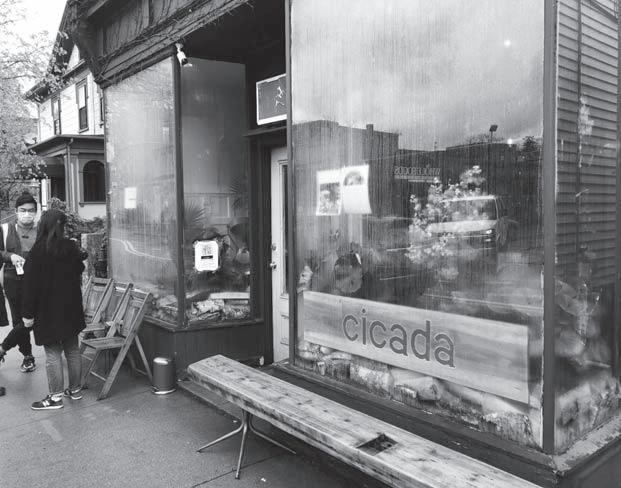 By Julia Remick Metro Editor
By Julia Remick Metro Editor
A photograph of a vibrant red archway in Mexico next to a red “for rent” sign draws public attention in an otherwise empty Newtonville storefront window. As a part of a new public art initiative sponsored by Newton Community Pride, vacant Newton storefronts will display professional artwork in an
effort to beautify the city.
“It’s a lovely opportunity to have shoppers and diners and pedestrians stumble across a beautiful piece of artwork, as opposed to brown paper cardboard or a for lease sign, so it makes a nice addition to our villages,” Gloria Gavris, board chair of Newton Community Pride, said.
The project, called WindowART, incorporates the pieces from Newton
Community Pride’s annual FenceART project, including local artist Howard Fineman’s “Nestled Arches, Mexico.”
This public art initiative is a submission-based competition that displays winning artists’ work on fences throughout Newton, such as at the Newton Free Library and the Newton Senior Center.
A jury of professional artists selects 20 submissions to be printed on vinyl banners and displayed throughout the year.
Newton Community Pride rotates the art among five Newton fences every 10 weeks, beginning in October and November, Gavris said. Submissions to the competition were open to artists who reside, work, or participate in art classes in Newton.
“In looking at the past inventory that we had we said, ‘Why don’t we repurpose them and use them for window art?’” Gavris said. “And that’s exactly what we did.”
The three by four foot vinyls from the 2019 and 2020 FenceART project will be on display for a minimum of 60 to 90 days, according to Gavris. She said that the artwork from the 2021 project is currently on display on the fences.
“Works that would have normally just been rolled up and put away are now being repurposed and given a second
life,” Gavris said.
Artwork has been installed in the last week and a half at two locations, according to Gavris. The locations include on Washington St. in the trio courtyard and at 34 Langley Rd. next to Johnny’s Luncheonette.
At the storefront on Langley Rd., Sidney Hutter’s The Clear Group - 3 Plate Glass Vases, which features three geometric glass vases, is on display along with two other pieces.
“If the storefront gets rented we would take them down, but we can rotate them amongst different locations, so that they don’t get tired and then the same pedestrian or shopper isn’t looking at the same thing,” Gavris said.
While these are the only display locations currently, Newton Community Pride is hoping to generate more interest from property owners, Gavris said. Interested vacant storefront owners can submit a location request for artwork.
The number of pieces on display at each location depends on the window size, and there are currently 16 vinyls on display, Gavris said.
“It depends on the size of the window, if they’re long and narrow we’ll try to find a long and narrow piece of artwork, if it’s a very big space we might be able
to put up two pieces of artwork at that location,” Gavris said.
The artwork encompasses a variet y of mediums and subjects, includin g photography, sculpture, and pottery. The various pieces pull from unique disciplines, Gavris said.
Vacant storefronts across village centers point to the impact of COVID-19, Gavris said.
“I suspect some landlords and some retailers were unable to pay the rent, because of lack of pedestrian and foot traffic and shoppers and unfortunately had to close down,” Gavris said. “So I see just amongst my travels within the villages, there’s at least two or three vacant retailers that have gone out of business.”
Because of the pandemic, Newton Community Pride has pivoted its focus to public art initiatives since January, Gavris said.
WindowART is the group’s third public art initiative, another being the Newton Al Fresco project that focuses on beautifying outdoor dining spaces in Newton, according to Gavris.
“So, it just looks to try to add a little bit more color and creativity to an otherwise bleak looking window,” Gavris said. “Just to have new residents experience quality art when they least expect it.”
Cicada Opens In Cambridge With Coffee and Pastries
By Maggie Leahy Assoc. Metro Editor
As the end of a school year like no other approaches, college students throughout Boston need their caffeine more than ever. In the face of looming finals and a multitude of papers, the Vietnamese coffee shop Cicada Coffee Bar might just be the perfect study escape.
Though small, Cicada is charming, w ith plants in the windows creating a calming atmosphere. George Fei, a regular at Cicada, said the aesthetic storefront was one of the first things that drew him into the coffee shop.
Frequenting the Central Square neighborhood in Cambridge often, Fei said that he became a customer this March after the coffee shop opened in late February. Though he passed by the storefront often with his friends, Fei said social media played a role in his discovery of Cicada.
“We walk by here frequently, and we saw a sign that indicated that the space was going to be something else,” Fei said. “And then, I saw an article on Eater about a new cafe opening, and then we followed them on Instagram … We came here like almost as soon as it opened.”
But, Fei is not Cicada’s only returning customer. While sitting in the fashionably decorated space, a newcomer can
see that the owner and staff of Cicada know the regular customers by name.
“I think they also make an effort to know their customers well, so every time we go in there, they either recognize us or like recognize our names, and [are] like ‘oh hey … we’d like to offer you something special today,’” Wenwen Teh, another loyal customer and Fei’s friend, said.
Co-owned by chef Vinh Le and Duong Huynh, Cicada’s interior decorations are soothing and stylish with a variety of chic, retro decorations throughout the space.
“I’m a bit of a self-described ‘plant daddy,’ so … I noticed the window [with] ... all the plants,” Fei said. “When I walk in I see the owner has a potted fig tree, like not a basic ficus lyrata … a common fig, [this one is] ... legit … I thought that was so cool.”
The aroma of coffee mingles with the scent of burning incense in the store, making the coffee shop both cool and inviting. Cicada’s motto is “Live slowly to understand deeply,” and the coffee shop lives up to this by creating a space where customers can stop and savor their coffee before continuing on with their day, according to its website.
“It looked like a pretty cool place that you would want to spend time in or work [in] even,” Teh said. “And then their food was really good. It felt like a really
interesting take on Vietnamese coffee.”
Cicada’s coffee is viet phin dripped, which uses the phin—a traditional metal filter that is similar to a French press. This process of making coffee takes time, as it is filtered drip by drip.
Cicada offers several unique drinks including the Sea Salt Shaker, an iced coffee with Maine sea salt and sweetened condensed milk, and the Back to Black, which has notes of pine wood and vanilla, according to its menu. Among its sweeter options is the coconut affogato—coffee served with Toscanini’s coconut ice cream.
For those that don’t drink coffee, tea-based drinks such as the turmeric and ginger-infused Golden Latte are also available.
Cicada’s menu is pescatarian and vegetarian, offering light meals to pair with its coffee. There is a variety of banh mi, a classic Vietnamese sandwich, along with several noodle dishes available. Cicada also offers a small selection of baked goods, including a blackberry crumble Danish and a cream scone with orange zest.
While the menu is not overly expensive, as most specialty coffees are around three to six dollars and food is around 10 dollars, Cicada discounts its day-old baked goods for $1.50.
Despite the pandemic, Cicada’s small
space is bustling on a Saturday morning, and its best pastries sell out quickly.
Currently, all orders must be submitted online, and customers can scan a QR code to order. All food and drink orders are packaged in compostable, single-use containers, and Cicada encourages its customers to throw away their waste in a compost located near the back of the store.
Be it the calming atmosphere, its coffee selection, or its trendy decor, Cicada
creates a trendy space for its customers to pause and enjoy their coffee. Cicada’s growing popularity is undeniable with its loyal returners, and it seems likely that its fan base will continue to expand after the pandemic.
“You know, had it not been the pandemic, this definitely would have been a place I would’ve frequented just to sit and feel the vibes,” Fei said. “Literally everything on their menu is great … I think it’s so good.”
THE HEIGHTS
Fuller, Council Oppose Gun Store Opening in Newton
A10 MONDAY, APRIL 26, 2021
JULIA REMICK / HEIGHTS EDITOR
Three pieces are on display in the vacant storefront on Langley Rd. in Newton Centre.
MAGGIE LEAHY / HEIGHTS EDITOR
Gun Store, from A1
The plants displayed in Cicada’s window create a serene ambience for customers.
Spectacular Collapse Costs Eagles Series Win
BY LUCAS GIRARDI Heights Staff
Three times in the last 63 years of the MLB has a team led by eight runs heading into the eighth inning and lost the game. Out of the 3,238 games in that situation, the winning team has managed to hold onto its massive advantage 3,235 times.
If an over 99.9 percent chance of winning sounds like a foregone conclusion of victory, then Boston College baseball’s bullpen would say otherwise. BC’s pitching staff has struggled all season, but Saturday’s display of self-defeating generosity by the Eagles’ relievers was a new low for a team that cannot get out of its own way.
After falling 5-2 to No. 6 Notre Dame (20-9, 18-8 Atlantic Coast) in the first game of Saturday’s doubleheader, the Eagles (16-21, 6-18) held a hefty 9-0 lead by the sixth inning of the second contest, due in large part to an early offensive explosion and a seven-inning gem from Alex Stiegler.
Stiegler recorded a season-high seven innings of work, giving up just one run and six baserunners.
BC head coach Mike Gambino opted for Joey Walsh in the eighth inning, and the wheels promptly fell off, as a combination of Walsh, Charlie Coon, and Joey Ryan gave up 12 runs. The Eagles could


not recover and fell 13-9.
BC was on the verge of claiming its first series win since its miraculous win over Auburn to claim the series, but home runs from Notre Dame’s Niko Kavadas and Zack Prajzner and walk trouble from the bullpen allowed the advantage to slip away.
The Eagles produced one run in the first inning but drove out Irish starter Tanner Kohlhepp quickly with a five-run third inning. He loaded the bases after hitting Jack Cunningham and walking Vince Cimini, so Notre Dame head coach Link Jarrett went to the bullpen to bring in Joe Sheridan.
In his 2.2 innings, Kohlhepp gave up five runs—four of them earned—on three hits, two strikeouts, three hit batters, and a walk. Sheridan could not get the last out to clean up his mess, giving up a single, a walk, and a double before getting Sal Frelick to pop out.
Sheridan’s struggles continued into the fourth, and Jarrett pulled him in favor of Alex Rao after giving up back-to-back hits to start the inning. Rao intentionally walked Cunningham, loading the bases with one out. A throw home beat Brian Dempsey for the second out, but Rao couldn’t escape the jam against Dante Baldelli, who added his second hit of the game with a two-RBI single up the middle, extending BC’s lead to 8-0.
Baldelli finished the game 3-for-4 with four RBIs. A string of Notre Dame errors and passed balls allowed BC to put up one more run in the fifth, putting the Irish down 9-0.
The rapid decline of BC’s bullpen allowed the Fighting Irish to climb back into the game. Walsh stepped onto the rubber with a 9-1 cushion, and surrendered a solo homer to Kavadas, his first batter. After two more Notre Dame players got on base, Prajzner took Walsh yard as well to cut the lead to 9-5 midway through the eighth.

Walsh got the next batter to ground out, and the Eagles needed just one more out to end the inning. The graduate lefty could not seal it, though, giving up a four-pitch walk and a single. Gambino pulled Walsh in favor of Coon after he hit Ryan Cole.
Coon walked three batters straight, and BC suddenly held just a one-run lead. Ryan entered the game as the third BC pitcher of the inning, and an infield hit allowed two more runs to score for Notre Dame’s first lead of the game. The Fighting Irish piled up three more runs for a staggering total of 12 in the inning, and Gambino resorted to Max Gieg to end the inning with a strikeout.
BC cycled through five relievers in just two innings, spoiling Stiegler’s gem and letting another lead slip away, which has been a trend the Eagles can’t seem to escape this season.
In game one of the doubleheader, Mason Pelio received the nod. Though he gave up three early runs across the first two innings, he pitched four more scoreless frames. Pelio opened the game by loading the bases right away but only allowed minimal damage, with a sac fly and a delayed

Notre Dame racked up 12 runs in the eighth inning to complete
steal putting Notre Dame up 2-0 in the first.
Notre Dame chipped away for one more run in the second inning, and the Eagles responded by loading the bases up with no outs in their half of the inning. Notre Dame starter John Michael Bertrand escaped the inning unscathed, however, getting Cimini and Peter Burns to ground out, while Cunningham was thrown out at third base.
The two teams exchanged a scoreless next four innings, and Bertrand retired 12 Eagles in a row. Pelio worked with at least one runner on base every inning, but he limited
the Irish to 1-for-12 with runners in scoring position.
BC bats finally came alive in the seventh, as a Cody Morissette single and a Luke Gold double forced Notre Dame to go to the bullpen. Bertrand recorded two runs on four hits, three walks, and a strikeout over 6.1 innings. Kohlhepp, who started the second game of the doubleheader, entered in relief and retired the next two batters, but the Eagles plated two runs in the process.
Kavadas added two insurance runs for the Irish with a homer in the ninth, his first of two on the day, to give Notre Dame its final 5-2 scoreline.
North Nominated for 2021 Tewaaraton Award
BY OLIVIA STRONG Heights Staff
A video of a stick trick that went viral in January 2020 made Boston College lacrosse star Charlotte North famous among women’s lacrosse fans—that is, if she wasn’t already. With over 180,000 views, lacrosse players all over the country were inspired to recreate North’s moves, and she gained a loyal fan following. Adding to her claims to fame, North was named one of 25 players nominated for the 2021 Tewaaraton Award on Thursday. Each year, the Tewaaraton Award goes to the top collegiate male and female lacrosse players in the country, comparable to football’s Heisman Trophy. The only Eagle to win the award is Sam Apuzzo, who won in 2018 and is now a coach for the Eagles.
Over a full year after North’s stick
trick went viral, it turns out that video was just a preview of the heroics that North would perform in maroon and gold. After transferring to the Heights from Duke, North’s first season as an Eagle was cut short due to COVID-19, but she has made up for lost time this year.
Much like Apuzzo, North is known for her dominance on draw controls, winning 118 so far this season. Only one of the 24 other nominees has recorded more.
Her impact doesn’t stop there. Prior to Thursday’s game against Syracuse in which she logged five goals, North was tied for eighth place in the ACC with 65 total points, including 57 goals and eight assists in only 12 games. She is the driving force behind the Eagles’ offense, often taking on the opposing team’s best defender—or taking on a constant face guard—but still averages 4.75 goals per game.
North’s likeness to Apuzzo isn’t limited to a parallel in draw controls. The year Apuzzo won the Tewaaraton, she finished the season with 88 goals (third in the NCAA), 41 assists (19th), and 129 points (third)—26 more than any other BC player. If BC makes a deep run in the postseason, North is on track to at least match Apuzzo’s goal total.
North set herself apart from Apuzzo on April 11 of this season, however, breaking her current coach’s threeyear-old record for goals in a game.
Apuzzo found the back of the net nine times against Navy in 2018—the year she won the Tewaaraton—and North netted 10 in a win over Virginia Tech.
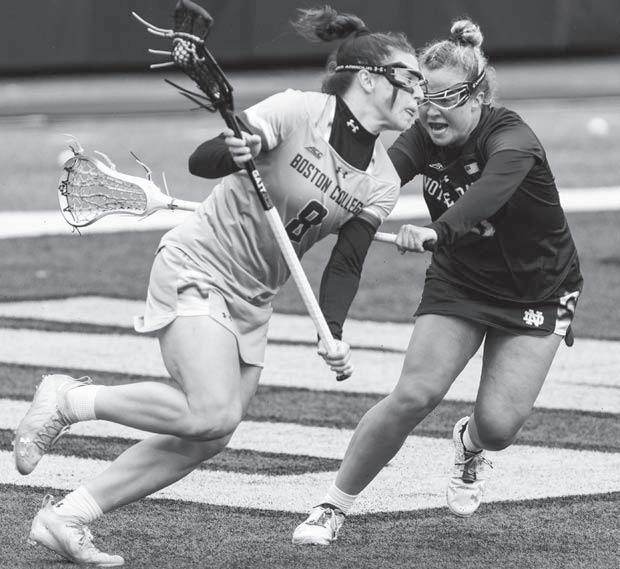
The nominee pool for the Tewaaraton will be narrowed down to five players in mid-May, and despite the competitive list of players, North has made her case.
BY SAM ARCAMONE Heights Staff
Pittsburgh softball entered Saturday’s doubleheader on a roll. Winners of six straight, coming off a four-game sweep against UNC last weekend and adding two more to the win column against Boston College on Friday, the Panthers were rising through the ACC standings and overcoming their earlier struggles this season.
With a win or two over BC on Saturday, Pitt (16-27, 6-19) would have found itself squarely in the ACC playoffs, with a cushion between it and No. 10 UNC. The Eagles (10-27, 6-19) had other ideas. BC took both games of Saturday’s doubleheader, coming from behind to win the first game 3-2 and securing an 8-4 victory in the second.
Heading into the bottom of the fourth of the second game, BC trailed 4-3. With four Panther hits in the top of the inning, including RBIs from Chandler Walter and Kayla Lane, it was the Eagles’ turn to respond. BC proceeded to follow the Panthers’ long inning with one of its own. Pinch hitting for Jenna Ergle, Payton Cox
started the rally with a single into right with one out. Gianna Randazza followed her and shot a liner into the right-center gap for a double, scoring Cox from first and tying the score at four.
But, the Eagles weren’t done yet. Shortstop Djhane Valido singled, moving pinch runner Erika Andal to third, still with one out. After Ellie Mataya moved Valido over with a groundout, freshman left fielder Elisabeth Laviolette stepped up to the plate with two runners in scoring position and two outs.
Laviolette drilled the Panthers’ Brittany Knight’s 2-1 offering up the middle, driving in both runners. Nicole Giery then singled to shortstop Morgan Batesole, and her sister Kristin did the same, scoring Laviolette from second for her third hit of the game. At the end of four, BC led 7-4.
Susannah Anderson, who entered in relief in the top of the fourth, settled in after giving up a few runs and blanked the Panthers for the rest of the game. After a scoreless fifth in which Pitt had two hits and stranded two in scoring position, Anderson didn’t allow another hit in the last two innings. The Eagles added one more in the bottom of the sixth on a Nicole Giery double into the gap to earn their second win of the afternoon
In the first game, Anderson pitched a
complete-game gem, allowing two runs for the first of her two wins on the day.
In five of her seven innings she sat three down in order. The only time the Panthers got going was in the fourth, when Anderson surrendered two of the three hits that she allowed all game.
EC Taylor led the inning off with a single, and Cami Compson walked.
Sarah Seamans grounded one to Emme Martinez, which she took to the base for a putout and two outs in the frame.
Hunter Levesque then put a double down the right-field line, scoring both runners for Pitt’s sole runs of the game.
In the bottom of the fifth, trailing again by a run, BC put itself ahead for good. Mataya and Laviolette started their half of the inning with singles, and Kristin Giery sent a double into left, scoring Mataya from second and advancing Laviolette to third. With two outs, Gianna Boccagno singled to the shortstop, putting the Eagles up by a run at 3-2.
One run was all Anderson needed. She sat the Panthers down in order in the sixth and, after the bases were loaded with no outs in the seventh, escaped the inning with two smooth infield putouts at home plate and a strikeout to finish the game.
A11 THE HEIGHTS MONDAY, APRIL 26, 2021
ADITYA RAO / HEIGHTS STAFF
After dropping Friday’s doubleheader, BC swept Saturday’s games to even the series.
ADITYA RAO / HEIGHTS STAFF
a comeback win.
Sweep Doubleheader With Pittsburgh Pittsburgh Boston College 4 8 JESS RIVILIS / HEIGHTS SENIOR STAFF North has led BC in practically every statistical category for the second year in a row. Pittsburgh Boston College 2 3 Notre Dame Boston College 5 2 Notre Dame Boston College 13 9
Eagles
APRIL SHOWERS BRING ZAY FLOWERS
BY EMMA HEALY Sports Editor
For the first time in nearly two years, fans sat in the stands of Alumni Stadium. Though it was minimal in size, the fan section—made up of Boston College football family members spread out across the bleachers on the field’s west side—was a welcome return for BC’s annual Jay McGillis Memorial Spring Game.
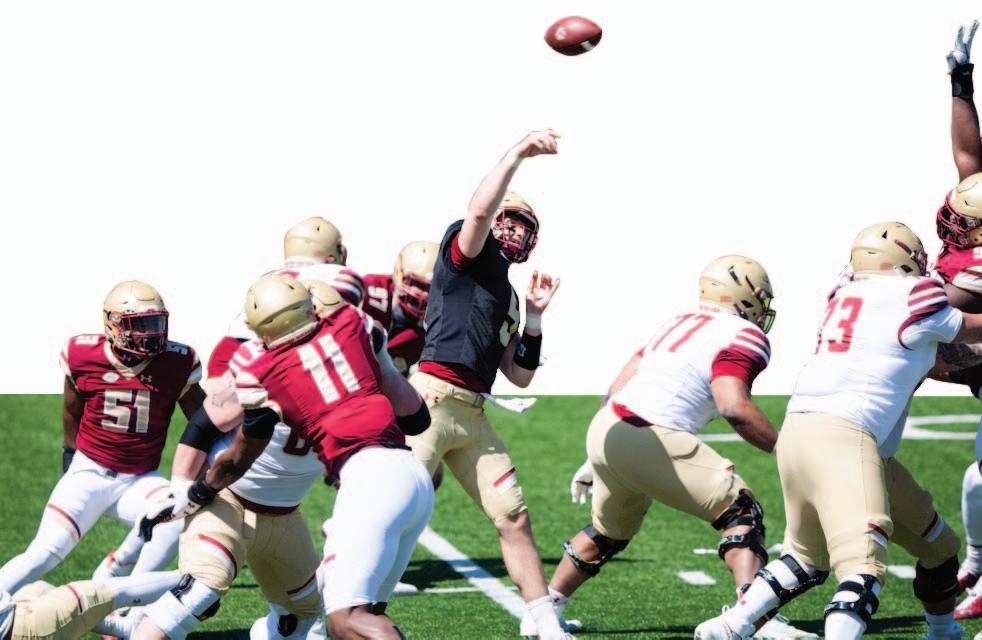

“It felt different. It was cool,” start-
times, with minimal quarterback pressure and takedown tackles, it’s hard to truly evaluate BC’s offensive production. Still, Jurkovec threw for 196 yards and two touchdowns, and Grosel finished with 128 yards through the air and 23 on the ground.
Late in the second half, BC switched to a red zone drill-style game, as teams traded off starting at the 20-yard line for the remainder of the contest.
Hafley turned to the full depth of his extensive receiving corps. Zay Flowers, an All-ACC Second Team selection last year, recorded three catches for
that he opted for a simple, base-level game plan on both sides of the ball but that expanding that versatility is a priority of his.
“We believe the backs that we have right now are versatile enough to line them up, bring them back in, throw the ball in the backfield, throwing the ball spread out—that’s going to be an important part,” Hafley said.
Special teams was the only phase in which Hafley and his staff didn’t attempt a game-like scenario. After no kickoff to start the game, punts featured only the punter, the long snapper, and

over Alumni Stadium’s speakers. Denzel Blackwell on defense and Bond on offense stood out in particular.
“It’s gotta be some jitters for those guys too, even though this isn’t really a game,” Hafley said. “It’s their first time in the stadium with people there, it’s on TV, so it’s just such a great opportunity for them to play in this environment in a situation like this, so I’m proud of those guys.”
Even Nick Bearup, the former BC club ultimate frisbee player–turned walk-on defensive back, made an appearance, though he was called for
it 10-0 after one quarter.
Jurkovec struggled to connect with even his veteran receivers until late in the second quarter. But in typical Jurkovec-to-Flowers fashion, the quarterback found his favorite target on a stretch play to the back corner of the endzone.
Team Boston then got the ball back when Jalen Williams intercepted a
BY OLIVIA STRONG Heights Staff
Everything was going right for Boston College lacrosse—a nine-game win streak, three top-five wins in a row—everything was falling into place. That is, until it wasn’t.
With the ball loose just a few feet in front of Syracuse goalkeeper Asa Goldstock, BC’s offense began to prepare to drop back to defense, anticipating a turnover. Suddenly, Cara Urbank rounded the crease and scooped up the ball, giving her an easy one-on-one situation with Goldstock, and the attacker netted the first tally of the game under one minute into the contest.
BC’s quick lead gave the impression that the Eagles would put up a fight against Syracuse for the second time this season, perhaps even coming away with another win. After a nail-biting win over the Orange two nights prior, BC was exhibiting all the signs of a team peaking at just the right time.
The game’s next few minutes, however, said otherwise.
In a battle for the No. 2 seed in the ACC Tournament, No. 4 BC (12-2, 8-2 Atlantic Coast) fell to No. 3 Syracuse (122, 8-2) in blowout fashion. A 16-7 final scoreline marked just BC’s second loss of the year. Though the Eagles netted the first goal of the game, Syracuse quickly rebounded and earned a lead that the Or-
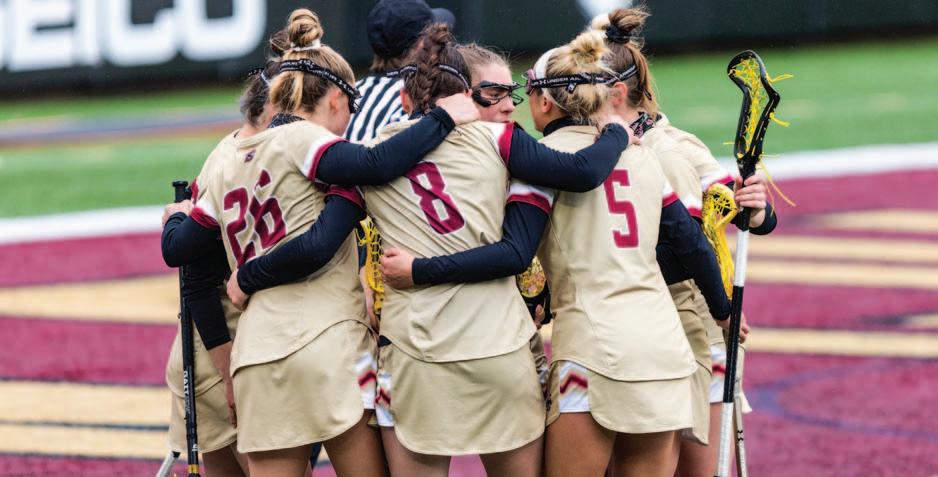
ange maintained until the final horn blew, never once showing signs of wavering.
Although it took the Orange over 10 minutes to find the back of the net when the two teams met for the first time on Thursday, Syracuse wasted no time on Saturday. In the first half alone, Syracuse logged eight unanswered goals, keeping the Eagles’ offense at bay for nearly 18 straight minutes. Urbank broke the goal drought with her second of the day, quickly followed by Jenn Medjid. Still, Syracuse’s lead remained sizable, as the Eagles trailed 8-3—their largest first-half deficit of the season by a longshot.
The loss of leading scorer Megan Carney, who was injured in the Orange’s previous game against BC, potentially spelled disaster for Syracuse, but if anything, it was the Eagles who struggled while Syracuse flourished.
A number of missed passes and shot clock violations led to BC having nine turnovers in the first half alone, compared to Syracuse’s three in that same span. Both teams recorded 12 shots in the first half, but BC went wide with all but seven of them while Syracuse was right on the money for 11 of its 12 shots.
Syracuse added two more goals to its already seemingly immovable lead before the half was over, while Belle Smith put her name on the board once, and the period ended with a score of 10-4.
Medjid kicked off the second half scoring once again, closing the gap to just five goals. In Carney’s absence, Syracuse’s
Prior to Tyrrell’s goals, though, BC head coach Acacia Walker-Weinstein opted to pull Rachel Hall from net in favor of Abbey Ngai. Through her 34-plus minutes on the field, Hall conceded 11 goals and recorded just two saves—out of the ordinary for the star netminder transfer from Oregon. Then, in under a minute on the field, Ngai conceded two. She went on to only allow five total Orange goals and tally three saves.
Syracuse is known for its three-man
weave at the top of the 8-meter arc, and despite already having faced it once this season, BC had trouble following the Orange players, frequently leaving them with wide-open shots on net. This trouble on defense allowed Syracuse to score three goals in quick succession before BC could find the net again. Hollie Schleicher earned her first goal of the season with just under 20 minutes left, followed by Smith once again to close out the Eagles’ scoring.
Syracuse went on to add three more goals to its total before the final horn.
Notably missing from the stat sheet
was Charlotte North, BC’s top scorer and a Tewaaraton Award nominee, who was held without a goal for just the second time this season. Also out of character for North was her five draw controls, four fewer than her 9.08 per game average. With BC’s loss, the teams split the weekend series, meaning that the seeding for the ACC Tournament deferred to goal differential due to the teams’ identical records. Because of Syracuse’s wide margin of victory on Saturday, the Orange earned the No. 2 seed, while BC will be No. 3 and face No. 6 Virginia in the first round of the ACC Tournament this week.
A12 THE HEIGHTS MONDAY, APRIL 26, 2021
Boston College Syracuse 7 16
Emma Tyrrell stepped up, scoring six goals, including two rapid-fire tallies 24 seconds apart early in the second half.
Team Eagles. Grosel got on the board to open the scoring with a 17-yard tuck and run to the end zone. Freshman placekicker Connor Lytton added a 25-yard field goal to make
BC Suffers Loss to Syracuse in Blowout Fashion
After a close finish on Thursday, the
a
JESS RIVILIS / HEIGHTS SENIOR STAFF
Eagles suffered
blowout at the hands of Syracuse for just their second defeat of the season.
20 16
Team Boston Team Eagles
d r ic running g b g d, or that unin ose st y ody m.
Receiver Zay Flowers and quarterback Phil Jurkovec picked up right where they left off in the fall with a standout performance in BC football’s annual Jay McGillis Memorial Spring Game.
IKRAM ALI / HEIGHTS EDITOR
Field t e in p se a th
IKRAM ALI / HEIGHTS EDITOR


















 BY CHARLEY CONROY Heights Staff
BY CHARLEY CONROY Heights Staff







 BY LAUREN JASEN Heights Staff
BY LAUREN JASEN Heights Staff

































 By Julia Remick Metro Editor
By Julia Remick Metro Editor








